Business to Business (B2B) Search Engine Optimization (SEO) is organic search visibility increasing strategy to increase the revenue, conversions, brand value, and organic traffic on search engines such as Google, Yandex, Microsoft Bing, DuckDuckGo, and Yep. B2B SEO involves business analysis, and content marketing for key decision-makers such as CEOs, CMOs, and CFOs. Business to Business Search Engine Optimization helps small and big businesses to achieve their sales targets. B2B SEO focuses on industrial businesses as buyers and sellers to create revenue. B2B SEO is different from Business Consumer (B2C) SEO.
What is B2B SEO? B2B SEO is the optimization of Business Websites for better search rankings on Google, and Bing-like search engines. B2B SEO provides better business economics by increasing sales for industrial channels. B2B SEO has its own challenges such as low search demand for keywords, the requirement of expert authors, intense corporate communication, small and lesser-known markets, and the requirement of multilingual content for different countries. To exceed the B2B SEO challenges with B2B SEO Strategies, using various search engine optimization verticals such as Local, Technical, Semantics, and PageSpeed optimizations are required.
What are the facts about B2B SEO?
- B2B SEO Strategies involve content marketing, writing, the keyword (search query term) research, topical map creation with semantic SEO, local SEO verticals, and Technical SEO.
- B2B SEO with Content Marketing: Content marketing involves making content visible, shareable, and consumable by the targeted audience while answering the questions of the market.
- B2B SEO with Technical SEO is to improve the crawling and indexing efficiency of the website for better and faster organic search results and search rankings.
- B2B SEO with Local SEO is to provide better local relevance, explorability, and entity-oriented search reputation by optimizing the Brand SERP, further.
- B2B SEO with Page Loading Performance Time Optimization is to improve conversion rates, and usability of the website for mobile, desktop, and portable web surfing devices such as handheld smartphones, and desktop computers.
What does B2B SEO Guide focus on?
The content of the B2B SEO Guideline is given below.
- B2B SEO Guide involves B2B SEO Strategies.
- B2B SEO Guide explains Content Marketing, Writing, and Publishing strategies that involve communication campaigns.
- B2B SEO involves social media marketing and crowdsourcing for better brand visibility.
- B2B SEO Guide involves a B2B SEO Case Study with over 100% Organic Click Increase
What is B2B SEO?
B2B SEO is to create an organic search conversion funnel according to the B2B customer’s search journey with long-term marketing strategies for ranking on search engines, primarily Google. B2B SEO involves conducting keyword research, creating a buyer persona, establishing expertise and authority for an industry with thought leadership, and comprehensive content marketing. B2B SEO best practices change according to the business industry. For example, SEO best practices for a business from the tourism industry changes compared to an enterprise for laser cutting. Large and small businesses need different B2B SEO Strategies. Thus, knowing the components of B2B SEO is important to create the best B2B SEO Strategy.
B2B SEO helps for eliminating the dependence on paid media while creating money pages that convert faster and better.
What are the Components of B2B SEO?
Components of B2B SEO involve the B2B SEO practices and their requirements, such as having knowledge domain experts as authors, and including thought leadership in the branding process. The conditions for B2B SEO are required for the components of B2B SEO practices. The conditions and components of the B2B SEO are listed below.
- Low Keyword Search Demand
- Longer and more Complicated Sale and Conversion Funnels
- Low Conversion Rate
- Thought Leadership
- Legit Online Presence
- Years of Experience Signals
- Trust Elements for Industry
- Digital Public Relations
- Certificates and Licenses for Industry
- Semantic Content Network
1. What is Low Keyword Search Demand?
Low Keyword Search Demand or Volume means that the number of searches for a specific phrase is lower than normal searches. Low search demand makes search engine optimization more details by explaining knowledge domain concepts and industrial trade components for the business. B2B SEO involves low keyword search demand by making the conversion funnels more complicated. Thus, to improve brand awareness and have topical authority in B2B SEO, brands need to process different but connected concepts and topics. For example, for accounting software, the brand needs to process accounting concepts, and methods or types to show the expertise, and canalize the users to the conversions.
2. Longer and more Complicated Sale and Conversion Funnels
The Longer and more Complicated Sale and Conversion Funnels in B2B SEO involve harder predictions for search behaviors. The market segments in B2B marketing are smaller than in B2C, thus the individual nature and personality create the difference when giving key decisions. Thus, the B2B SEO has more complicated sale and conversion funnels. Conversion path and funnel involve different types of theories, such as the 3 Click Theory, which states that every click funnel shouldn’t be longer than 3 clicks. But in B2B SEO, many companies need different channels for conversions, such as phone calls, emails, or video calls. B2B SEO Companies and Agencies focus on industry sale channels by creating a higher-profile communication campaign that involves Digital PR, news and press releases, and events for the industry. Complex B2B Sales funnels for SEO requires creating multiple landing pages, and multiple conversion actions, better call to action that explains the needs of the business’s key decision-makers. To create a million dollars worth of purchases in B2B Marketing, multiple meetings are required.
Using fairs of industry, show-rooms, 3D, and Augmented Reality technologies in B2B Marketing and SEO is needed for higher conversion rates and to increase the chance of complicated sales funnels. Fairs show the expertise of the brand, and leveraging fairs in SEO, especially Barnacle SEO methodology, helps B2B SEOs to decrease the needed phone calls or video calls before the conversion.
3. Low Conversion Rate
Low Conversion Rate is a component of B2B SEO, as complicated conversion funnels and low keyword search volume. The low conversion rate in B2B Search Engine Optimization causes due to value per sale. Value per sale involves the amount of monetary value per successful conversion. The value per sale and conversion rate is in inverse proportion. Low Conversion Rate in B2B SEO is measured differently from “click-to-sale” and “click-to-inquiry”. The “click-to-inquiry” conversion rate is higher than the “click-to-sale” conversion rate. Usually, “click-to-inquiry” conversion rates change between 4-11% according to the business industry, and “click-to-sale” conversion rates are not over 1% in B2B SEO. To increase B2B Conversion Rate, branding, and conversion path analysis and tracking are needed.
4. Thought Leadership
Thought Leadership is expertise for a certain topic or area to demonstrate professionalism, success, and experience with unique value. Thought leadership is a way of marketing, and expressing of talents and dedication of the person. Thought leadership belongs to a person who has exponential growth and success in an industry. Thought leadership in B2B SEO helps for boosting industry presence while building brand awareness faster. B2B SEO leverages thought leadership to be a reliable source and authoritative brand for a specific topic. Content marketing, social media marketing, and online and offline event ownership are different ways of showing thought leadership. As Thought Leadership examples, Steve Jobs, and Fran Blanche can be given. And, Apple SEO Project leveraged Steve Jobs’ thought leadership for higher brand awareness for many years.
5. Legit Online Presence
Legit Online Presence involves proof of the legality of the company such as a legal address, phone number, email address, company founders’ identity, headquarters, names of teammates, their background, and views for the company, a tax ID, and license of the company. Legit online presence is reflected on review and complaint websites along with investment portfolio websites that include investors, companies, CEOs, and others. The Legit Online Presence helps for B2B SEO by improving the brand’s Expertise-Authoriteveness-Trustworthiness (E-A-T) in the eyes of search engines and users. A legit online presence helps for better conversions, especially in the B2B SEO, since most of the purchases cost hundreds of thousands of United States Dollars.
6. Years of Experience in Signals
Years of Experience signals involve the length of industrial activities of the company for the industry with invoices, successes, sales, and events. Google My Business (Google Business Profiles) shows the experience of the companies by giving its foundation date, and labeling it by saying in Business for 1, 2, or 3 and more years. Google’s understanding of serving the search results whether it is for local search results, whether web results represent their understanding. To show years of experience in B2B SEO for better organic rankings, demonstrating proof of long or intense experience is needed. Google search engine measures the expertise with historical data and consistency. Google doesn’t rank websites a few days after they publish their articles. Google B2B SEO requires patience and demonstration of expertise through reviews, case studies, publications, product variations, and unique value with consistency. Years of Experience in B2B SEO involves the main 7 components below.
- The foundation date of the company is a B2B SEO factor for demonstrating company experience.
- The intensity of the length of experience involves the value of the length of experience. A company with two years of experience might have better value than a company with 10 years of experience.
- Company Success Stories involve case studies, research, publications, books, webinars, seminars, education sessions, and social responsibility campaigns to demonstrate the business value to the industry. Company success stories help B2B SEO by creating brand value, and better E-A-T.
- Company Press Releases and Coverage helps B2B SEO by providing a corporate image by demonstrating the company’s value.
- Company CEO’s Length of Experience helps to strengthen the experience of the company. A company with 0 years of experience takes advantage of a high-level, experienced CEO.
- Company Product Line involves the products that the company produces. A long product line shows the success of the company with variations of the same product.
- Company Review Count and Review Deepness demonstrate the business feedback. Older reviews and detailed reviews show the experience level of the company in satisfying the clients and customers. B2B SEO and company reviews are connected due to E-A-T, and conversion funnels.
The experience signals help B2B SEO agencies to boost organic search visibility for small and large businesses, including enterprises with a faster conversion path.
7. Trust Elements for Industry
Trust Elements for Industry involve the trust signals such as positive relationships, good judgment, consistent success, and unique expertise. Trust elements differ between industries. For example, for a business in the automotive industry, the big automobile manufacturers as partners might signal trust for the company. Trust elements help for Business to Business search engine optimization to convince key decision makers for big purchases. Trust Elements as a component in B2B SEO help businesses for convincing more clients. Search engines use trust elements to filter unreliable web sources from the prestigious and confident service providers and product producers in B2B and B2C industries. The fundamental website and company trust elements for B2B SEO are listed below.
- Success Stories
- CEO Background
- Social Responsibility Projects
- Citations of the Company name in reliable sources
- Positive user and customer feedback
- Strong social media existence
- Having a live customer support
- Having an open address, phone number, and email address on the website
- Expertise signals such as unique research and rewards.
- Reliable partners in the business world
8. Digital Public Relations
Digital Public Relations for B2B Marketing and SEO involves different media coverage with magazines, newspapers, TV, and digital publications. The return on investment for Digital PR is higher than for Business to Consumer Digital Public Relations. According to a study by CMO Council, 87% of BtoB (Business to Business) buyers are affected by digital public relations and online content marketing. 17% of the B2B buyers meet with the suppliers through physical contact and meetings after the exposure to Digital PR. Digital PR for B2B SEO helps for acquiring more referring domains, and backlinks to increase the PageRank, and approval from the web while boosting referral traffic along with the trust for the company. The digital PR budget for B2B SEO is arranged according to cost-per-click metrics, and tangible results.
9. Certificates and Licenses for Industry
Certificates and Licenses for Industry are a part of B2B SEO to improve the trust and conversion funnel success. Certificates and Licenses for Industry norms help a business to prove its success, and authoritativeness, along with expertise for the specific topic. For example, the automobile industry needs certain types of manufacturing licenses, or automobile selling licenses, and for the laser cutting industry, the “HOBBY Series Certification”, and “Pro-Series” certifications are used. The used certifications and licenses should be specific to the brand so that the company can prove its responsibility. The B2B SEO leverages certificates, licenses, and media coverage of the company for further relevance and topical authority.
10. Semantic Content Network for B2B SEO
Semantic SEO, and Semantic Content Networks, are fundamental for B2B SEO. Creating a glossary for the industry, explaining production, and manufacturing methodologies, produced components, their types, materials, and service types. For example, a company from laser cutting and 3D Printing services has to cover all the materials, machines, machine parts, types, produced components, colors, and improvements. Covering all the possible phrase taxonomies, products, search intents, query networks, and groups, and reflecting the best possible lexical relations, and query semantics on web pages’ content is important for B2B Semantic SEO.
What is the Difference between B2B and B2C SEO?
B2B SEO and B2C SEO differences involve branding, content marketing, keyword research, and semantic SEO differences mainly. B2B SEO campaign budgets are bigger than B2C SEO campaigns, even if the B2C SEO campaigns require more authors and bigger content networks. To see the main differences between B2B and B2C SEO strategies, read the comparison table below.
| B2B and B2C SEO Components | B2B SEO | B2C SEO |
| Content Marketing | B2B SEO Requires higher topical coverage for deeper details for topics that require expertise. Covering B2B SEO topics is harder when compared to B2C SEO. | B2C SEO performs content marketing and publications for direct consumers. Thus, the content networks are more granular for different types of phrase taxonomies, but it doesn’t require a detailed amount as much as B2B SEO. |
| Keyword Research | B2B SEO focuses on low-search demand keywords and search queries. Explaining and creating content networks for low search volume queries is harder when compared to B2C SEO. | Keyword research for B2C SEO is easier than B2B SEO because there are more queries thanks to the size of the target audience and market. |
| Target Audience | B2B SEO targets business owners, or high-level managers such as Chief Executive Officers. B2B SEO creates content with different formats to convince key decision-makers. | The target audience for B2C SEO is larger than for B2B SEO. Thus, the average monetary value per purchase is way much lower but the purchase amount is higher. Thus, B2C SEO requires bigger teams than B2C SEO. |
| Branding | Branding is the main component of B2B SEO and B2C SEO. But, B2B SEO requires better branding since the average conversion value is way much higher than B2C SEO. B2C SEO sells products that might be cheaper than 5 USD, while B2B SEO focuses on millions of USD worth of purchases, thus Branding is a key component for B2B SEO. | Branding is a key component of B2C SEO, but convincing visitors is easier than B2B SEO. Thus, branding is important for B2C SEO, but not as much as in B2B SEO. |
| Semantic SEO Differences | Semantic SEO involves consolidating the relevance of a web source to a topic while creating more comprehensiveness and topical coverage for higher historical data by giving responsive information to the users. B2B SEO requires more details, thus the Semantic SEO for B2B SEO is harder and requires further expertise. | Semantic SEO for B2C SEO requires bigger topical maps, and more content items to be published with larger content authorship teams. B2C SEO content marketing and semantic SEO efforts might take a longer time, but it doesn’t require expert authors. |
What are B2B SEO Strategies?
The 15 main B2B SEO Strategies and tactics for improving the organic search performance of B2B companies are listed below.
- Analyze Buyer Personas for B2B SEO
- Determine a Target Audience
- Perform a Topical Research for Search Behaviors
- Analyze Competitors’ Web Pages, and Anchor Texts
- Extract all the Knowledge Domain Concepts and Experts
- Determine a Content Production Guide for Expert Authors
- Design Conversion Funnels
- Determine Conversion Steps and Obstacles
- Determine Content Production Formats
- Perform Internal Linking and Anchor Text Optimization
- Perform Content Expertise and Accuracy Check
- Improve Relevance, Accuracy, and Comprehensiveness Always on
- Analyze User-engagement and Conversions
- Use Omnichannel User Retention Practices
- Promote B2B Content for Digital PR
B2B SEO Strategies involve different methodologies and techniques from semantic SEO and Technical SEO verticals. Increasing crawling efficiency, creating a buyer persona, simplifying conversion funnels, building scalable content marketing, and producing strategy are different aspects of B2B SEO. Read the B2B SEO Strategies below to increase the organic search performance of B2B SEO projects.
1. Analyze Buyer Personas for B2B SEO
Buyer persona involves characteristics, demographics, and traits of the targeted market individuals. A buyer persona is used for messaging and planning content marketing. Interesting topics used on social media platforms, and instant messaging applications along with the search behavior of buyer persona help B2B SEO for content syndication, repurposing, and formatting. B2B SEO usually targets smaller markets and groups of people compared to B2C SEO. B2B SEO uses Buyer Personas to improve content reach, engagement, and conversions. Making detailed buyer personas decreases the complexity of B2B SEO. The questions that are asked, the feelings during the online or offline meetings, lead generation paths, and methods are optimized according to a buyer persona. In search engine optimization, buyer personas are used to analyze searchers’ backgrounds, so that related topics can be targeted within the same content network for better conversion funnel coverage. Conversion funnel coverage means touching more Moment of Truths during the buyers’ searching journey from the beginning to the end of the funnel. Buyer persona creation is called buyer persona development. Buyer personas are called marketing personas, target personas, or audience personas by marketers. B2B SEO uses the buyer personas for analyzing the traits below.
- Demographics of buyer persona involve age, gender, marital status, homeownership, ethnicity, religion, disability status, health, income, and education.
- Occupation and Economics of buyer persona involve debts, financial independence, occupation, and career.
- Interest areas and lifestyle of buyer persona involve house, car, transportation, sports, movies, books, and family life.
B2B SEO uses buyer persona traits to leverage communication with the targeted audience. Using interviews, contacts database, forms, and phone calls help B2B SEO to update and expand the Buyer Persona for better rankings and higher conversion rates.
2. Determine a Target Audience
Determining a target audience in B2B SEO refers to differentiating the group of individuals that are targeted for reaching out for B2B sales. Target audience and intended audience are two different marketing concepts. The target audience is directly for conversions while the intended audience is broader, and involves people who are interested in the topic, but far away from the conversions. Using target and intended audiences in B2B SEO campaigns help a brand increase its awareness and user loyalty.
Determining a target and intended audience for B2B SEO is helpful for connecting with target potential customers and turning visitors into customers. Having a flywheel marketing understanding is helpful to convert target audience individuals to brand ambassadors. B2B SEO is highly intersected with B2B marketing. To have a better brand search volume, and demand, or triggering Brand SERP features that promote the company’s successes with People Also Ask questions, Google-related search terms, or autocompletion is done by being closer to the target audience than B2B competitors. To determine a target audience in B2B SEO, use the referring domains of the competitors, forums, forum threads, questions, answers, influencers, and influencer interactions along with the video portals and search engines such as YouTube by analyzing their behaviors. Covering the targeted audience and market characteristics inside the website to increase brand penetration.
3. Perform Topical Research for Higher Coverage
Perform topical research for higher topical coverage for better organic search rankings and topical authority. Topical research is a method to cover certain topics along with search query groups and networks with the correct angle. Keyword research and topical research are different, but connected things to each other. Topical Research involves finding the main, sub, and side topics for a business for reaching out and covering the users’ search journey for the conversion funnel. Topical research is a method for understanding semantic web behaviors in the context of semantic search engines. Web users perform semantic search behaviors in certain patterns to reach out to a certain target on the open web. For example, searching for a dental implant material, and a specific material’s health effects, in the long run, are connected to each other. Both of these topics might be covered by different websites, such as a dentist website, or a dentist material website. According to the brand’s identity and the web source’s purpose, the topical research and topical coverage are performed by semantic SEOs.
Why is topical research beneficial for B2B SEO? B2B SEO uses topical research for proving thought leadership, unique information to prove the expertise of the source, and higher historical data for proving the web source’s consistent expertise and quality increase. The topical research benefits include proven expertise, and a higher user, and customer base.
4. Analyze Competitors’ Web Pages, and Anchor Texts
Analyze competitors’ ranking web pages and anchor texts in B2B SEO. Anchor texts are indexed by the semantic search engines to understand the conceptual connections and the topical-contextual alignment between the source and target pages in hyperlinks. The anchor text differences signal the topical connections between the web pages, to demonstrate the importance of the specific web page. Title, meta description, introduction paragraph, heading vectors and words, anchor texts, list elements, and table column names create the topicality of the page. The context mismatch between the web page content components such as anchor texts, or titles creates contextual relevance dilution. To prevent such a situation, understanding how search engine algorithms are trained by authoritative sources, and creating more granular and closer connections in a clear methodology is better.
The main improvements for the anchor texts and competitor web page comparisons for B2B SEO are below.
- Auditing anchor text words from competitor B2B competitors.
- Auditing words and terms appear in anchor text on B2B web pages.
- Checking harmony and alignment between headings, and titles along with headings and anchor texts.
- Exploring knowledge domain terms and expertise level of competitor B2B pages’ content for comparing the credibility.
- Matching the anchor text terms to the Google autocomplete suggestions for queries to see how the internal navigation of competitors and Google’s understanding of the search behaviors are aligned with each other.
The Competitors’ Web Pages signal the trust elements that are used for users and search engines E-A-T-related algorithms. Thus, auditing competitors’ pages for web page layout, trust, and communication elements including typography, design, and link positions are helpful for B2B SEO.
5. Extract all the Knowledge Domain Concepts and Experts
Extract all Knowledge Domain Concepts and Experts for B2B SEO. Knowledge Domain Concepts and Experts are used to signal the expertise level of the content related to the business industry. Using and defining the knowledge domain concepts by using the authority sources with the information consensus help to convince the users with high information literacy. The knowledge domain concepts include the terms that are used especially in the specific topical cluster. The contextual terms are used to demonstrate the topical relevance of the web source while showing its authenticity for the industry.
Having research, PDF files, statistics, surveys, and university citations for defining the knowledge domain concepts and being mentioned as an expert together with other experts help B2B SEO to prove credibility and topical authority. Using unique, richer definitions with examples for the knowledge domain concepts is a method for being a higher authority for the B2B Industry.
6. Determine a Content Production Guide for Expert Authors
Determine a Content Production Guide for Expert Authors in B2B SEO. SEO Campaigns shouldn’t use non-expert Authors, in B2B marketing. Business to Business industries requires a high level of expertise and deep information for the industry concepts, or production methodologies to prove the authenticity, uniqueness, and originality of the company. Content Production Guide educates Expert Authors to write and compose expert information for B2B Content Marketing. The content production guide is called the “Content Engineering Guide” in Holistic SEO since based on certain methods and principles the authors produce the content. Content engineering requires determining sentence structures, question and answer formats, average content detail, length, image, audio, or video production methodologies, style, and tonality of the content. The content production guide is chosen and designed according to the industry of the B2B SEO Campaign. For example, a B2B SEO campaign for Pharmacy needs to have a more serious and scientific article and content production methodology than the B2B Gift industry.
7. Design Conversion Funnels
Design Conversion and Click funnels for B2B SEO. B2B SEO has a higher pricing point that affects the complexity and patterns of Conversion Funnels. B2B Conversion Funnels have multiple channels such as emails, phone calls, form submissions, physical meetings, or in-person store visits. The forums and exhibitions are the least used but most converting parts of the conversion funnels in B2B Marketing. To prove the authority, uniqueness, and authenticity of the B2B Campaign, using every step and vertical of the conversion funnels in B2B SEO is needed. Including offline and online conversion channels and patterns together in SEO campaigns help for higher conversion rates, along with an average shorter timeline per conversion.
To design a proper conversion funnel for B2B SEO, the average click and visit count before the conversion is measured. The demographics, psychology, and most problematic steps in the conversion path are analyzed. The conversion funnel designs for B2B SEO are to simplify conversions while supporting the key decision makers and sales teams of international or small businesses. To simplify the conversion funnels, examining the questions that come from customers, listening to existing partners, attending exhibitions, and examining the audience are methods to improve B2B SEO conversions.
8. Determine Conversion Steps and Obstacles
Determine Conversion Steps and Obstacles for B2B SEO. Conversion Steps involve the moment of truth for performing the purchase. The moment of truth defines the moment that the customer decides to buy something. It is examined by marketers to understand how customers decide, or when deciding, to purchase a product. Conversion steps and obstacles for B2B SEO and marketing are connected to the moment of truth to analyze the multiple types of the moment of truth. Conversion steps for B2B SEO include familiarity, trusting, purchasing, and advocating for the company. The purpose of B2B SEO is not to sell a product or service only once, it is to have lifetime partner companies. Thus, the end step for B2B Marketing and SEO is having business partners from related industries with positive commercial relations. Thus, the obstacles for B2B SEO and Marketing are the amount of time for gaining the trust of the key decision maker and providing the service or the product end-to-end. Providing a product or service end-to-end means making everything ready for the buyer company. For example, a factory owner that buys certain types of machines needs software, training, transportation, and installation. Thus, partnership, companionship, and long-term business relations are needed in B2B Marketing. B2B SEO has to show the trustworthiness of the company with end-to-end service solutions to overcome obstacles of B2B SEO conversion funnels.
9. Determine Content Production Formats
Determine content production formats for B2B SEO. Content production formats involve the content forms for B2B SEO and B2B content marketing. The content formats such as PDF, PPTX, or Infographics, articles, videos, podcasts, audio, and music determine the communication style through content marketing. Choosing the correct content format for the correct content vertical is important. Content verticals involve the platform where the content is used for content marketing. Social media B2B Marketing and Podcast B2B Marketing are different from each other, thus selecting different content formats is needed. To perform omnichannel content marketing for B2B SEO, combining and deciding correct content repurposing and reformatting methodologies are used. For example, an international stock trading consultancy company for other companies requires podcasts rather than Instagram marketing.
10. Perform Internal Linking and Anchor Text Optimization
Optimize Internal Linking and Anchor Text for B2B SEO. Internal Links and Anchor texts help search engines to relate web pages to each other, while search engine crawlers understand the web pages’ purpose better. Every web page is created for a specific purpose. Thus, anchor texts describe the purpose of the web pages. The summary parts of the web page are the title tag, heading 1, and meta descriptions. The purpose of the web page, and summary parts of the web pages align with each other for better B2B SEO performance. The Internal Linking and Anchor Text optimization from a Business to another Business Search Engine Optimization are below.
- Close the anchor text gap for showing the naturality and relevance of the web pages to each other better.
- Do not use the anchor texts just for closing the anchor text term gap.
- Use only descriptive anchor texts, do not include words such as “read more”, or “click more” for anchor texts.
- Do not use more than 4 concepts in the anchor texts.
- Use the shortest anchor texts on the most important web pages for the most important pages.
- Limit the number of internal links on a web page to weigh the existing internal links more.
- Place the related internal links at the same or closer places to each other.
- Do not use the internal links before explaining the definition of the concept in the internal link.
- Explain the connection between linking and linked web pages to show the possible purpose, or the need, of the click on the link.
Internal Link optimization and anchor text types are helpful to understand the prominence of internal links for B2B SEO from user experience optimization and search engine optimization points of view.
11. Audit Content Expertise and Accuracy of Information
Audit content expertise and accuracy of the information and expertise level for B2B SEO. Auditing content accuracy requires checking the facts on the web page by classifying the factual information. Google and other semantics search engines try to have consensus for scientific topics by auditing the citations, and information sources, such as researchers. Auditing content expertise and accuracy of information require having an expert content manager, or the company’s own employees and teammates need to be experts. Search engines improve the quality and expertise thresholds for being ranked on search engine result pages. Thus, the need of including expert information with accuracy for B2B Content items, and expertise for the same knowledge domain is a must for the company’s team members.
What happens if there is inaccurate information in B2B Content? Google and Microsoft Bing are semantic search engines that understand inaccurate information by corroborating web answers from multiple web sources. The wrong, inaccurate, and misleading information on content signals low information quality on the website. Thus, algorithmic demotion for the organic search rankings happens over time. Understanding facts, and evaluating factoids are tasks for search engines to differentiate true authorities and experts from the imitated expertise.
Including Unique and First-time facts, and asking new and original questions to explain a knowledge domain, is an easy and efficient way for being a better authority.
12. Improve Relevance, Accuracy, and Comprehensiveness Always on
Improve Relevance, Accuracy, and Comprehensiveness always-on for B2B SEO. Improving the relevance and accuracy of the information in the web page content is related to content decay. Content decay is a fundamental concept for fresh and valid content. Freshness and Query Deserves Freshness are concepts for Google Search Engine ranking algorithms. Fresh web pages with updated and valid information have a higher click-satisfaction and ranking chance on the SERP compared to outdated content. The queries on Google Search are new by %25 every day, according to Google Search Relations. The new and unique search queries on Google are classified by the Hummingbird based on semantics and query clustering algorithmic decisions. The new information for a concept, or knowledge domain and new search queries for the fresh information make the old and non-updated content less rankable over time. Google Search Quality Rating Guidelines involve different types of outdated and decayed content examples to explain that the Page Quality score is not good enough to be ranked for web search engine users. B2B SEO requires to be improved, updated, and configured content for higher relevance, and comprehensiveness. The newly added information and possible combinations of questions are answered by adding new sections to the existing content or merging different content items.
13. Analyze User-engagement and Feedback
Analyze user engagement and feedback for B2B SEO. B2B SEO has a low conversion rate, thus analyzing the user engagement for B2B SEO mostly involves non-returning users or informational user behavioral metrics. To analyze the user engagement for a B2B SEO campaign, there are 3 main steps. First, segment the website into different parts in Google Analytics 4, or other web analytics technologies for differentiating user behaviors from each other. Second, analyze user-flow metrics to see which pages have the highest exit rate, and when the users do not scroll down or perform their visit purpose. Third, use A/B tests with tools and technologies such as Google Optimize to understand how the users give feedback while visiting the website. Analyzing user engagement and feedback is beneficial to make the content more responsive to the users’ possible and related search activities.
14. Use Omnichannel User Retention Practices
Use Omnichannel User Retention Practices for B2B SEO. SEO is not done only via Google search pages. Holistic SEO involves every vertical of the web including social media, video portals, news publishers, podcasts, etc. Thus, omnichannel user retention practices are related to Holistic and B2B SEO. Omnichannel User Retention involves communicating with the user via multiple communication channels such as email newsletters, YouTube channel subscriptions, website visits, or push notifications. Omnichannel user retention helps to improve conversion rate and have more brand advocates. According to the Holistic SEO, users that follow a brand from social media, and subscribe to the newsletters of the same brand convert by a %25 higher possibility.
15. Promote B2B Content for Digital PR
Promote B2B Content for Digital PR for B2B SEO. Digital Public Relations (PR) is the process of improving brand awareness by positioning a brand for higher quality and authority in the perception map of consumers. Digital PR helps brands to improve their prestige, and trustworthiness along with their popularity. Having a higher search demand with positive sentiments, having higher positive reviews, or acquiring external hyperlink references (backlinks) help Google search engines to trust a web source with higher confidence. Increasing the PageRank of a website, and its relative importance in a link graph helps a website rank higher by proving its trustworthiness and quality. The Digital PR provides external references and mentions along with reviews by showing the brand as an authoritative source. Thus, Digital PR and Business to Business SEO are related to each other. Promoting B2B Content with Digital PR to show authoritativeness by being mentioned by national and local news publishers, editorial opinion owners, and thought leaders helps for higher organic search rankings in B2B SEO.
16. Increase Page Speed and Crawling Efficiency for Users and Search Engines
Increase Page Speed and Crawling Efficiency for Users and Search Engines for B2B SEO. Technical SEO and B2B SEO are connected to each other. Page Speed and Crawling Efficiency for a better user experience, and a faster, less-costly crawling experience for search engines are required for B2B SEO. To improve Page Speed or decrease page loading time, there are 5 main techniques. These are using server-side compression technologies such as Brotli and GZIP, minifying HTML, CSS, and JS files by removing the whitespace, using a Content Delivery Network (CDN) for faster server response times, using less resource request count, and smaller resources. The crawling Efficiency of a website means how efficiently search engine crawlers crawl the website. The metric for measuring the crawling efficiency of a website involves the amount of resource crawl hits compared to valuable web page count and total time for crawling the website. Crawling efficiency increases if the resource crawl hits are less compared to the valuable web page count. Crawling time is another type of cost for the crawling efficiency calculation that decreases crawling efficiency when crawling takes longer time for the website. B2B SEO and crawling efficiency are related to each other because search engines do not prefer a non-crawlable and indexable or highly costly website for being crawled for ranking purposes. Low-cost and high-value websites are always more important for being ranked in B2B SEO.
To allocate and arrange the web development resources of the B2B SEO Campaign, having a solid relationship with the Chief of Technology Office, and web developers in the company is needed. Preparing Technical SEO and page speed improvement tasks for CTO and web developers with clear documentation, and practical involvement to improve B2B SEO efficiency with technical aspects.
17. Increase the Historical Data of the Website by Staying Active with Higher User Satisfaction
Increase the Historical Data for the Website by Staying Active, with Higher User Satisfaction. Historical data involves the user’s activities over a period of time on the search. Historical data is used by search engines to evaluate the websites for ranking and quality assessment. Historical data without a proper quality signal from the search behaviors data cause websites to lose traffic, while high-quality websites give higher quality signals over time. Google Broad Core Algorithm Updates use historical data to change the prioritization of web sources. To have enough historical data, search engines wait enough time for performing and testing an algorithmic update. Historical data and B2B SEO are connected to each other. A website with higher historical data has a higher potential for being evaluated by the search engine with higher confidence. Search engines work with machine learning algorithms by labeling websites with critical dimensions such as their quality, identity, design, and layout. The rule-based systems and machine learning (ML) algorithms work together to evaluate the websites with historical data. B2B SEO and Historical Data are connected to each other. Because, to have higher historical data, the website needs to have higher search activity. Thus, having higher mentions, reviews, impressions, clicks, or mouse hover effects or being ranked in the image pack, and other types of search activities help websites to increase their historical data. The positive user feedback historical data helps SEO Campaigns to increase their chance of being ranked. The B2B SEO requires a higher topical coverage to increase the positive historical data for being evaluated by the search engine as an authoritative source. Every negative user feedback from a search behavior that affects the historical data decreases the ranking of the website and increases the chance of demotion during the Broad Core Algorithm Updates. Thus, increasing positive user-feedback occurrences in the historical data of search behaviors is required for B2B SEO Campaigns’ successes.
What are the Most Important Steps for B2B SEO Strategies?
The most important steps for B2B SEO Strategies involve using having an omnichannel user retention strategy, having a strong brand existence with digital public relations and brand positioning, writing and producing expert-level accurate and unique information, being a thought leader for the industry, and simplifying the conversion funnels for the business. The most essential and critical steps for B2B SEO Strategies are related to having a target audience with an accurate buyer persona, and a connection with the decision-makers through the beginning and bottom of the conversion funnel.
SEO Case Studies for B2B Industries
The B2B SEO Case Studies in Holistic SEO include heavy metallurgy, laser cutting, CNC machining, 3D printing, Plastic Injection Molding, Pool Construction, and Mass Gift Production industries. The B2B SEO Guide of Holistic SEO includes two different websites. One is a company from New York that works in the industries of heavy metallurgy, 3D printing, CNC Machining, and printing, molding, and manufacturing on demand, and the other one is from the pool construction business. In the next sections, the successful SEO Case Studies in B2B markets are explained.
B2B SEO Case Study for Heavy Metallurgy Industry
The B2B SEO Case Study subject website name is kept hidden due to the NDA agreement below. The subject website for heavy metallurgy B2B SEO is a multimillionaire Wall Street company. A section from the NDA Agreement to keep the website’s and brand’s name hidden for possible SEO case studies or other types of activities is given below.
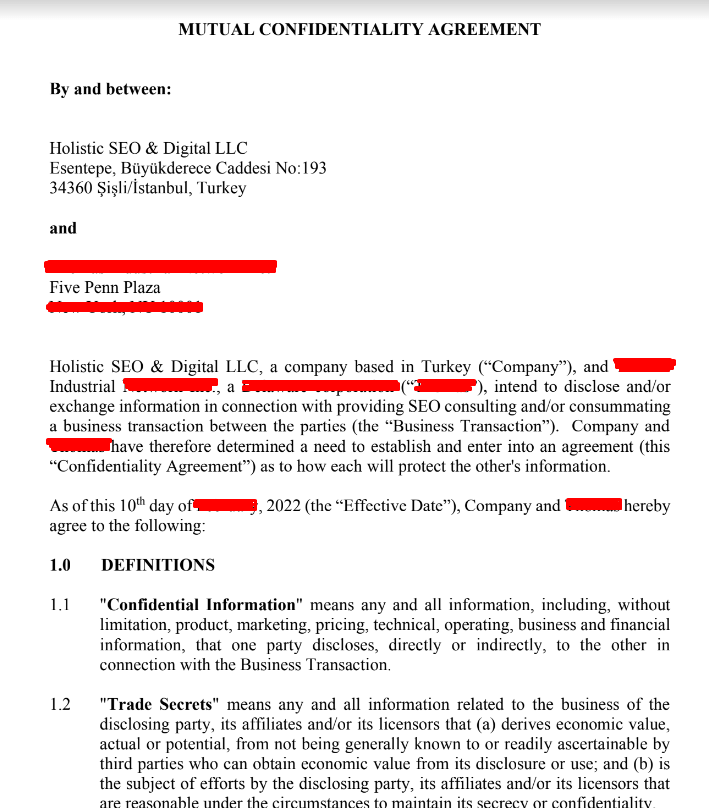
Results of the B2B SEO Case Study for the Metallurgy Industry
The Heavy Metallurgy Industry B2B SEO Case Study results are given below.
- 115% Organic Click Increase in 3 Months YoY Google Search Console Performance Comparison
- 97.6% Organic Impression Increase in 3 Months YoY Google Search Console Performance Comparison
- 36,000+ New Organic Search Queries
- 1126 New Top 3 Ranking Organic Search Queries
- 2665 New Between 4-10 Organic Search Queries
- 34,000 New 10-100 Organic Search Queries
The Heavy Mettalurgy Industry B2B SEO Case Study results from Ahrefs to demonstrate the over 100% organic click increase in 5 months are below.
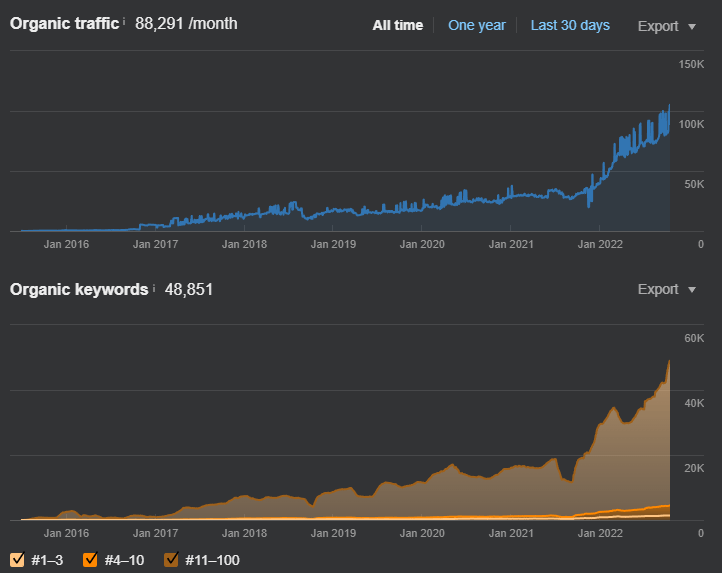
One month later, the B2B SEO Project’s organic search performance is visible below, with another 20% organic click increase and a %15 query count increase.




The Heavy Metallurgy Industry B2B SEO Case Study results from SEMrush to demonstrate the over 100% organic click increase in 5 months is below.

The B2B SEO Project’s performance graphic from another SEO traffic tracker is below with another %15 organic search, and a %7 query count increase, after 1 month.

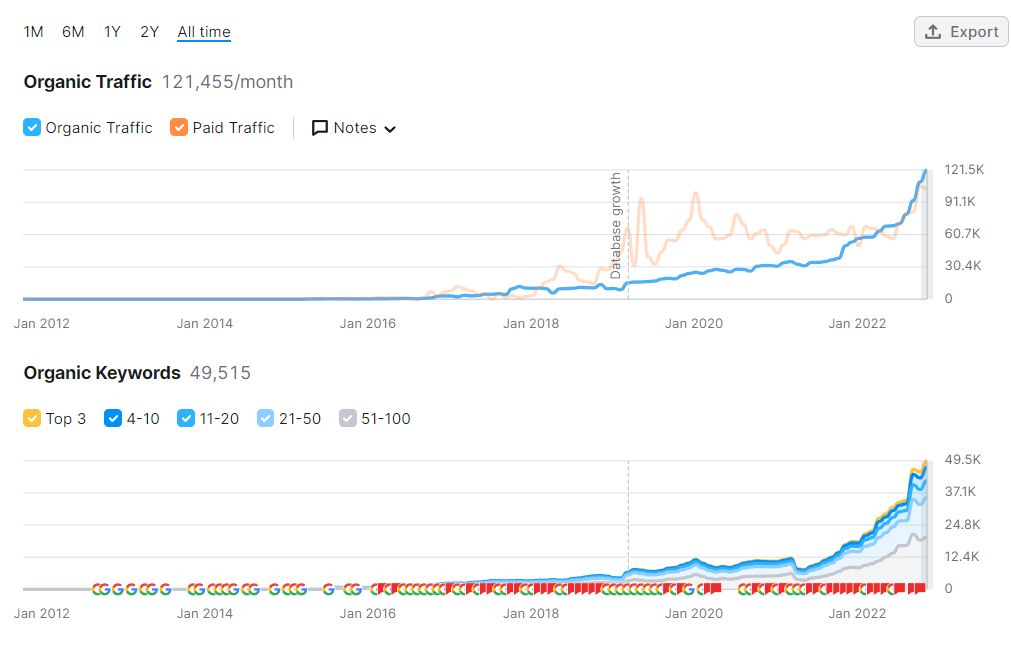

The Heavy Metallurgy Industry B2B SEO Results from Google Search Console are given below as naked.

One month later, the organic search performance for the last 6 months reached from 370,000 clicks to 507,000 clicks.

The 3 Months Year-over-Year Comparison that demonstrates over 100% organic click and impression increases from Google Search Console for the B2B Heavy Metallurgy SEO Case Study is below.

One week later version of the Organic Search Performance of the B2B SEO Project is below. The website reached another organic click and impressions peak inside the Positive Ranking State.


The Google Search Console performance report for the B2B SEO case study demonstrates positive ranking and traffic growth is above.

Same comparison, one more month after the version is below.


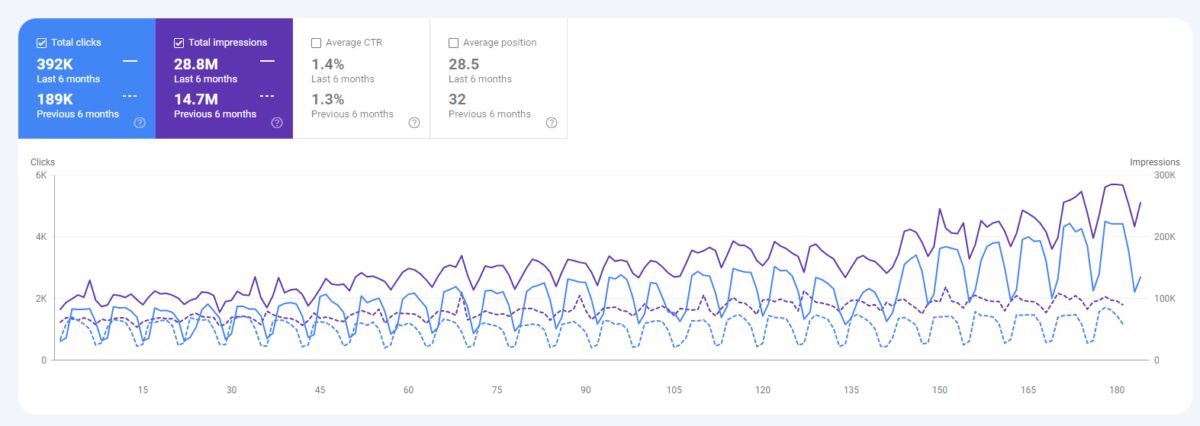
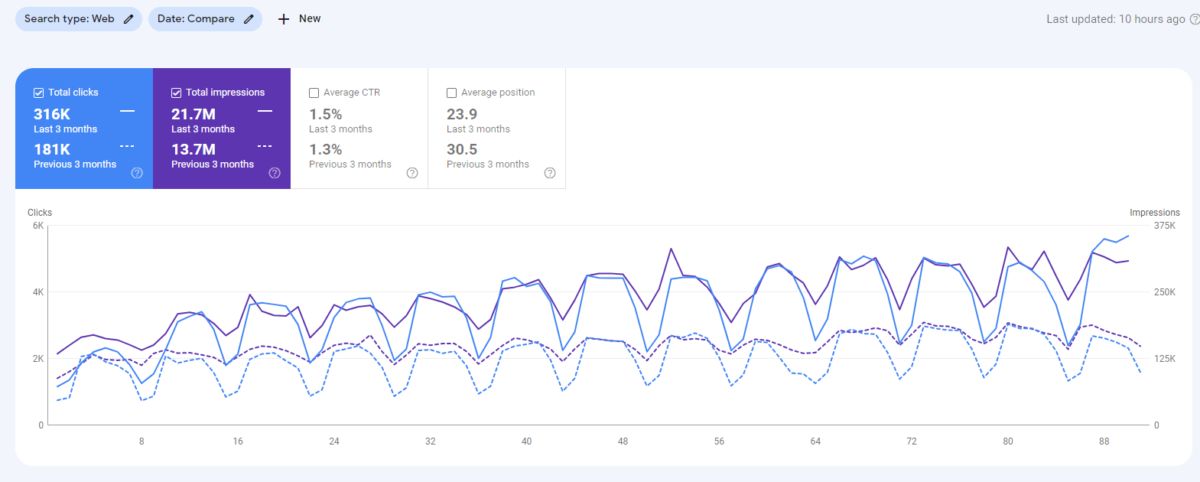
Using the Pages and Crawl Stats Reports of Google Search Console for B2B SEO
The results for the B2B Metallurgy SEO Case Study from Pages and Crawl Stats reports are below.
- The Not Indexed and Indexed Page balance is important for Cost-of-Retrieval.
- The Not Indexed Page count shouldn’t be higher than the Indexed Page Count.
- The Indexed Pages should have enough level of quality so that the search engine continues to crawl and value the website.
- The Total Crawl Requests for the source are on the left side.
- The 786,000 crawl request is a high amount, but since the response time is below 200 MS, the source is able to save itself despite non-necessary resources and pages.
Below are the visuals of the Crawl Stats and Pages Reports of GSC for Metallurgy B2B SEO Case Study.

The Crawl Stats from the Google Search Console Report for demonstrating the file types and Googlebot type for the characteristics of crawl hits for B2B website is below.
- The source doesn’t show the HTML Documents as it should be shown to the search engine.
- To have a better B2B SEO Result, the website should prioritize the indexable content in crawl stats such as HTML, and Image files rather than JSON, or CSS and JavaScript files.
- Thus, the Resource Load hits are too high.
- It demonstrates a High-level of Cost of Retrieval.
The JSON, JavaScript, and CSS resources have a higher percentage than HTML documents. HTML Documents are crawled around 17% which shows the real indexing value resources do not take attention from the search engine due to a crowded source code which signals the need for a re-organization of the coding structure of the website.
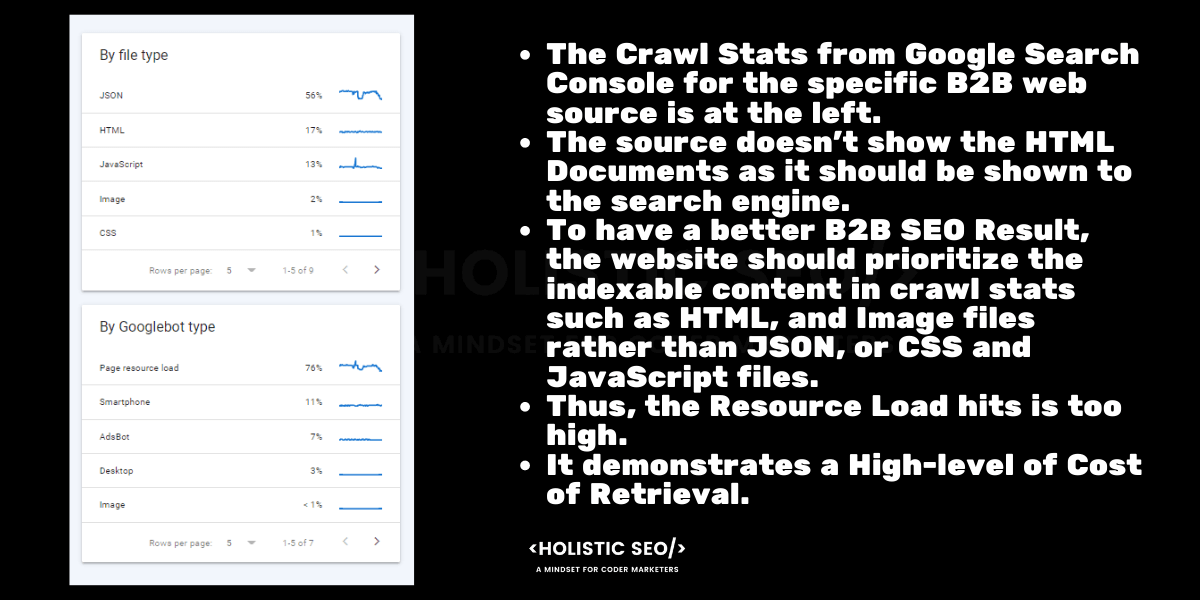
The Response Code distribution from the GSC for B2B SEO involves the responses of the web server of the B2B SEO subject website for the requests of the Googlebot. The 304 and 200 status codes are valid for a healthy crawling profile for SEO, including B2B Vertical while internal redirects, and 404, or 302 URLs should be cleaned by improving the internal crawling signals of the website. The results of the B2B SEO Metallurgy Website’s GSC Crawling Report’s “By Response” and “By Purpose” areas are below with their results.
- Having 304 and 200 status codes over 90% in total is important.
- Here, the %92 of the response codes are actually 200 and 304 Status Codes.
- It shows that the website has a healthy crawling response code.
- It incentives search engines to crawl further for finding the content since it doesn’t waste resources.
- The %3 Discovery Crawl Hits help source to refresh itself in Google’s index by showing that the website is actually an active source.
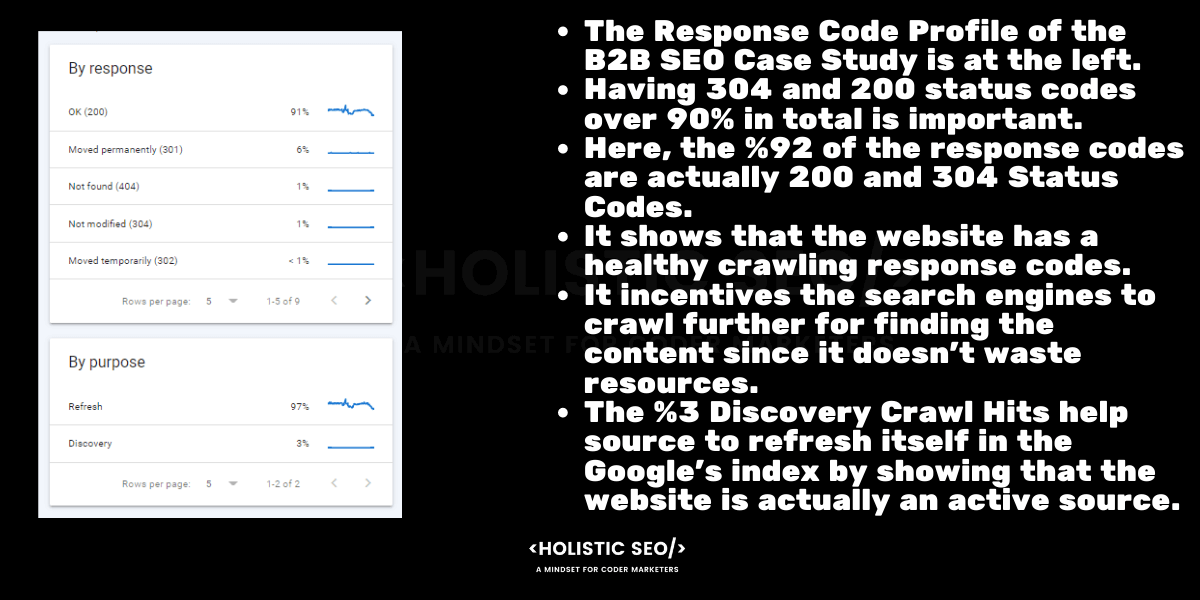
Using Google Search Console Page Experience Report for B2B SEO
The Core Web Vitals Report of Google Search Console demonstrates the real-user experience data for specific page speed metrics such as largest contentful paint, cumulative layout shift, and total blocking time. The Core Web Vitals for B2B SEO matter, especially for more competitive niches. The results of the GSC Page Experience Report for the B2B SEO project are below.
- The Core Web Vitals affect the rankability of the sources for competitive niches.
- Since there are multiple candidates to be ranked, the User Experience and the page loading time become more important.
- The B2B SEO Case Study Subject Website doesn’t pass the Core Web Vitals.
- Only 32.7& of the URLs pass the Core Web Vitals on Mobile, and 71.3% of desktop URLs pass the Core Web Vitals.
- The Mobile CWV improvements are correlative with the ranking increase.
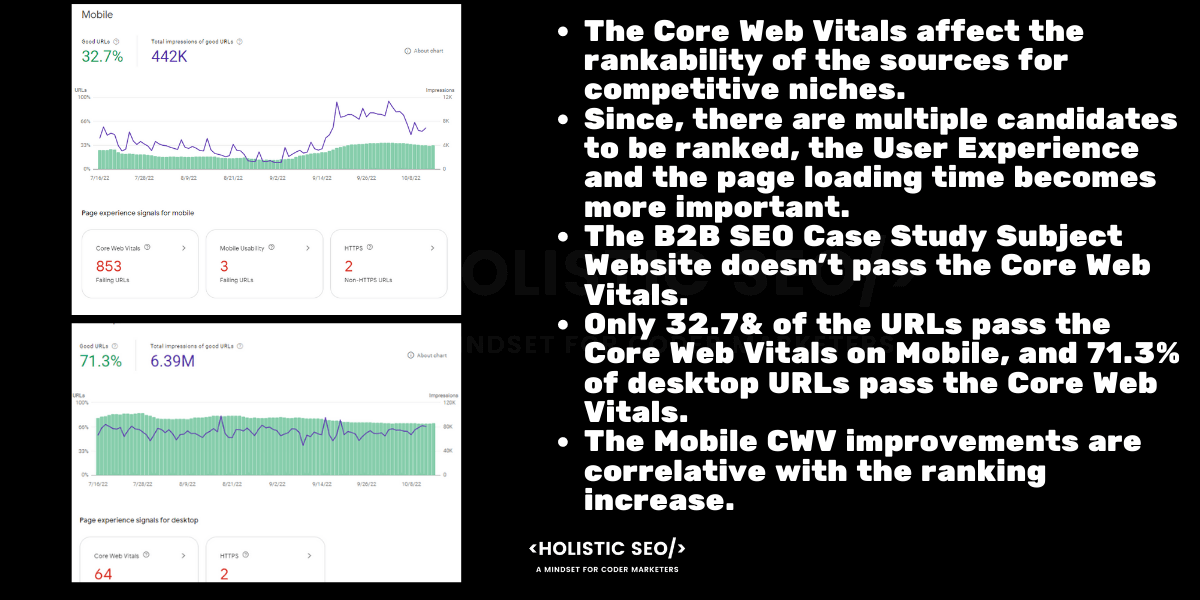
The image clicks and impression performance changes overall for the B2B SEO Project are below.

The image SEO performance comparison for the B2B company SEO project for the last 6 months is below with the key points and strategic points.

B2B SEO Case Study for Pool Construction Industry
The second B2B SEO Case Study in B2B SEO Guide is from Pool Construction Industry. The pool Construction industry is a hard and tiny, but valuable niche in providing millions of dollars of income per sale. Thus, the traffic that is acquired in these topics is really valuable. The B2B SEO Case Study from Pool Construction Industry involves many technical SEO problems, but thanks to the brand search-demand increase, and semantic content network creation, it increased its overall authority and topical relevance. The Pool Construction B2B SEO Case Study subject website involves multilingual SEO since it exports its products to other countries.
The name of the Pool Construction Company name is explained in the future coming book “Information Responsiveness in SEO”, and after the launch of the book, the name will be added here.
The Results of B2B SEO Case Study in the Pool Construction Industry
The results of the B2B SEO Case Study from the Pool Construction Industry are given below.
- 254.24% Organic Click Increase in Google Search Console in 3 Months YoY Comparison
- 299% Organic Impression Increase in Google Search Console in 3 Months YoY Comparison
- 6672 New Organic Search Queries
- 364 New Top 3 Ranking Organic Search Queries
- 544 New Between 4-10 Ranking Organic Search Queries
- 5900+ New Between 10-100 Ranking Organic Search Queries
The Pool Construction Industry SEO Case Study results from Ahrefs with organic search performance graph are below.
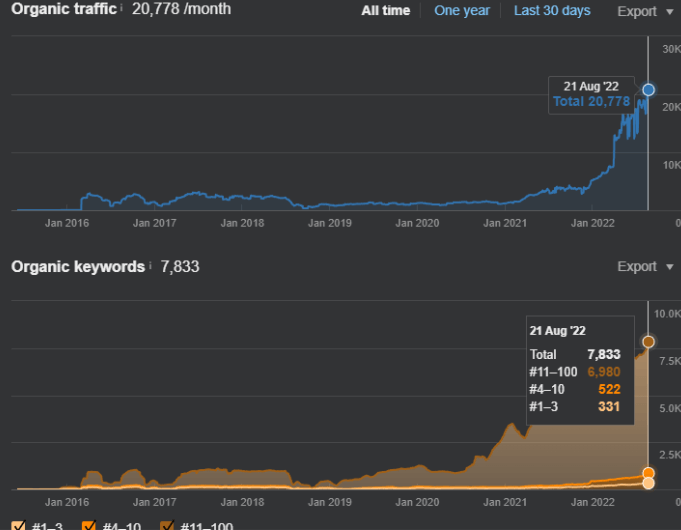
The Pool Construction Industry SEO Case Study results from SEMrush with organic search performance graph are below.
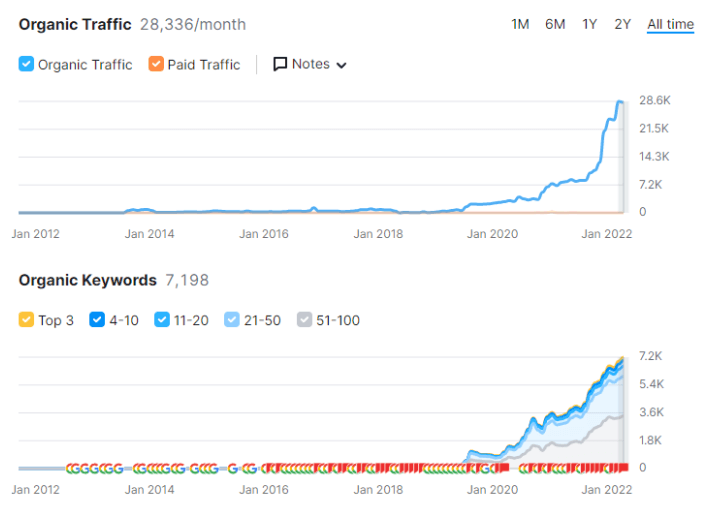
The over %200 Organic Click increase in 3 months of year-over-year comparison in Google Search Console for B2B SEO Case Study from the Pool Construction industry is below.

The overall organic click and impression increase from the naked and open Google Search Console Data for the B2B SEO case study is below.

The B2B SEO Case Study from Pool Construction Industry subject website has increased its positive ranking state further, and 2 weeks later, the year-over-year 3 months Google Search Console comparison graphic started to show a 254% organic click increase, and over 250% organic impression increase.


The Summary of the results of the B2B Pool Construction Brand’s SEO Campaign is below visually.
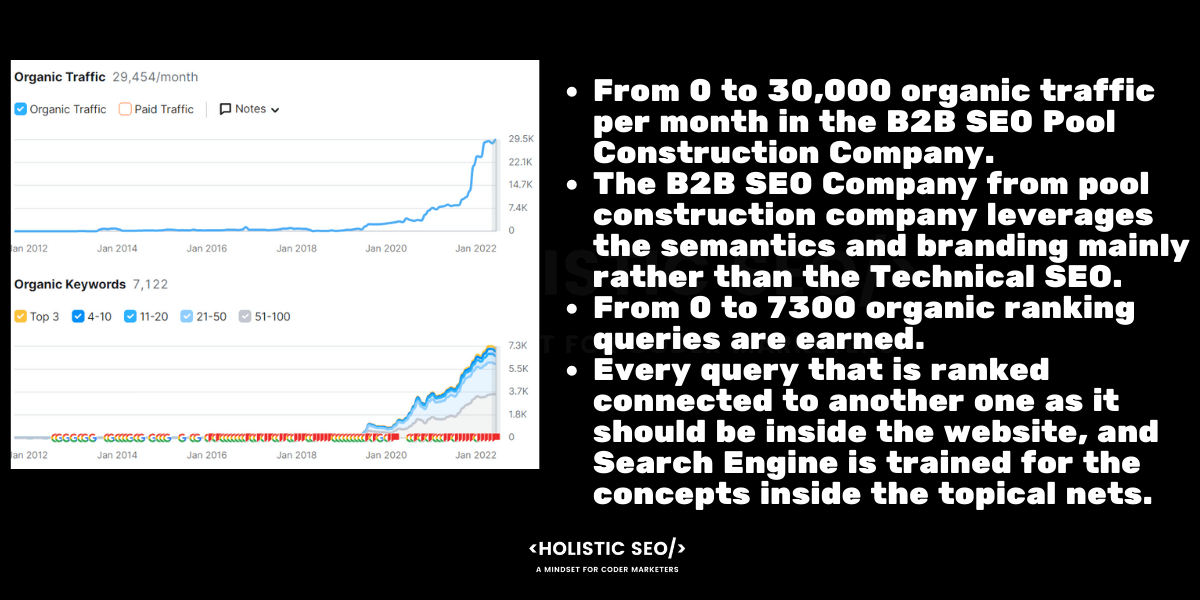
The second visual for the results of the B2B SEO for Pool Construction Company is below.

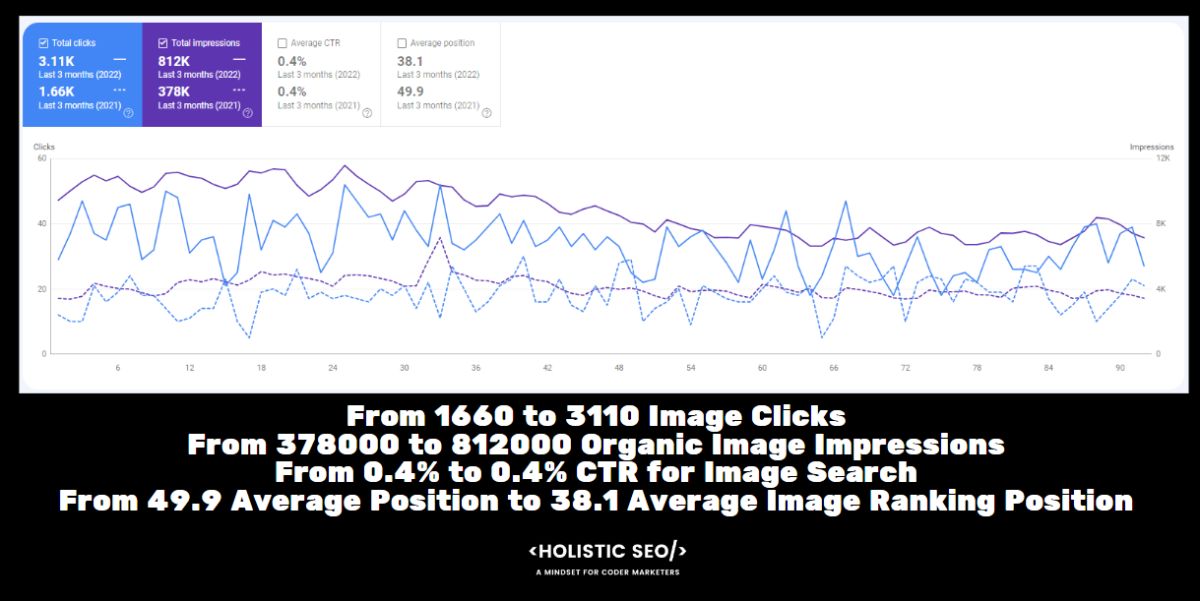

Analyzing Google Search Console Pages (Coverage) Report for B2B SEO
Analyzing Google Search Console Pages Report for B2B SEO requires understanding the prominence of Technical SEO for success. The “alternate page with the proper canonical tag” involves URL differences for the same or highly similar content, while “Not Found 404” pages are dangerous for the website’s trustworthiness and freshness along with the crawling efficiency. Most B2B SEO projects use old web development frameworks and systems, thus technical SEO problems matter more. The B2B Pool Construction SEO Case Study’s search console report for “Pages” is given below.
- The Page’s Report example from B2B SEO Case Study demonstrates the number of web pages that are not indexed from different verticals.
- Having Soft 404 pages, Duplicate without user-selected canonical, and pages with redirect decrease the quality of the crawl path while making the website costlier for the search engine crawlers.
- The B2B SEO Case Study from Metallurgy Industry shows that the content quality and brand authority might incentive crawlers further despite big numbers of non-indexed pages and unnecessary resources.
- The Pages Report from Google Search Console of the B2B SEO Company from Pool Construction Company.
- The high amount of 404 URLs, internal unnecessary redirections, Soft 404 URLs, and internal 404 URLs, server response errors are problematic.
- The “423 crawled not indexed” and “Discovered not indexed 263” URLs involve quality issues for some product pages.
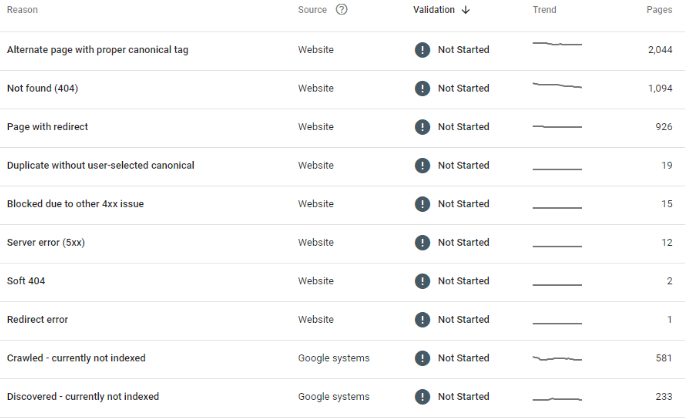
The Pages Report Analysis for the B2B SEO Pool Construction company visually is below.
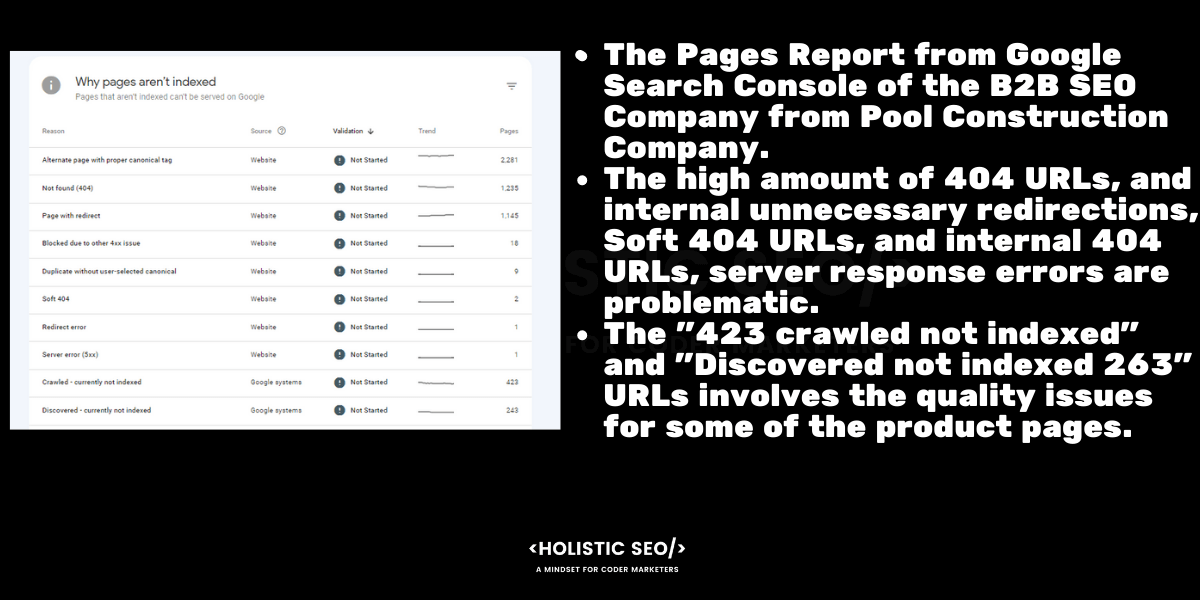
The indexed and non-indexed pages report of GSC for B2B SEO pool construction website analysis is below.
- The Pages Report from the Google Search Console of the B2B Pool Construction Company.
- The Not Indexed Pages count is higher than the Indexed Page Count.
- The Cost-of-Retrieval is high, while the unnecessary pages decrease the quality per web page.
- Despite that, the content pruning is implemented, thus the indexed and total page count is decreased.
The Indexed and Non-indexed pages analysis for B2B SEO involves the efficiency of the website for being understood and crawled to be indexed by the search engine. The visual expression of the analysis of the indexed and non-indexed URLs for the B2B SEO is below.
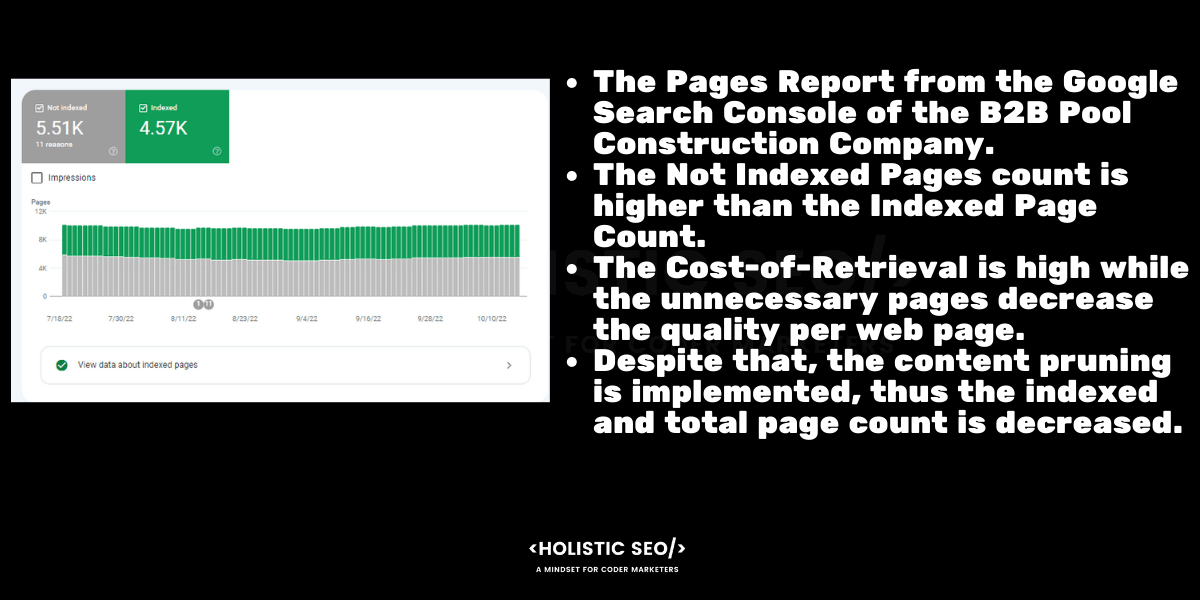
Analyzing Google Search Console Page Experience Report B2B SEO
Analyzing Google Search Console Page Experience Report B2B SEO involves the overall performance of the page speed and user experience of the web pages of the B2B campaign website. The mobile and desktop devices’ speed for rendering the B2B website’s web pages, and HTTPS along with interstitials usages, is helpful for SEOs to analyze the overall situation of the website. The Page Experience Report analysis for the B2B SEO project example is below.
- There are no good URLs, as stated before.
- There is no HTTPS URL problem.
- But, due to crawling pattern issues, there are Mobile Usability issues.
- The Mobile Performance issues affect the website slightly because B2B marketers and buyers usually use desktop devices.
- The good URL count in the Page Experience report for both mobile and desktop is 0.

Analyzing Google Search Console Page Experience Report B2B SEO
The analysis of the Google Search Console Core Web Vitals Report for B2B SEO involves a detailed version of the Page Experience Report for only the web page speed metrics and scores as “good, bad, and need improvement”. The classified URLs with example representations and scores are given for improving the performance of the B2B SEO project URLs. The Summary and the visual snapshot of the B2B SEO Core Web Vitals report are below.
- All the mobile URLs have direct “poor” performance scores.
- There is not a single good URL for the specific website.
- Still, the website is able to increase its performance thanks to semantic content network quality and publication frequency.
- Despite the bad Mobile Core Web Vitals, the website continues to rank higher.
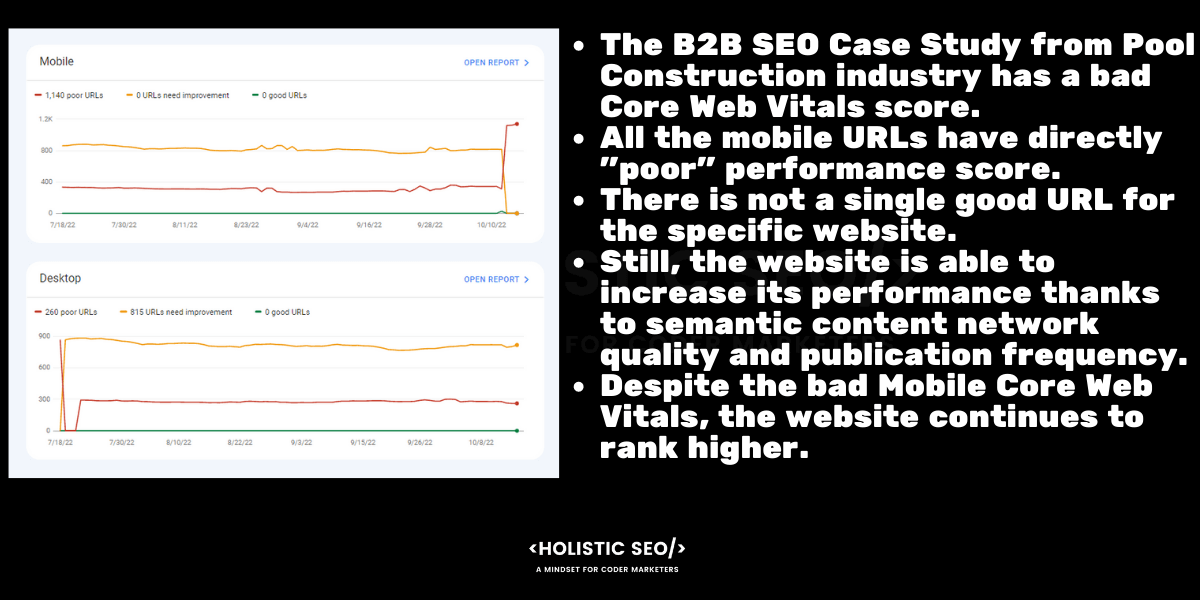
Crawl Stats for the Pool Construction B2B SEO Case Study Project and their Analysis
The crawl stats for the Pool Construction B2B SEO Case Study Project involve the total crawl requests, total download size, and average response time to analyze the project’s efficiency for communicating with the Googlebot systems. The B2B SEO Case Study crawling stats examples from the pool construction company are given below.
- The 66,000 crawl hit requests are not bad, but the average response time is over 3 seconds, which is awful.
- Being able to increase the rankings with such a bad time to the first byte for crawlers happened thanks to quality content production and brand authority increase.
- Technical SEO and Semantic SEO along with Brand Reputation support each other in B2B SEO.
- The average response time is over 3 seconds, which is more than 15 times what Google suggested.

Response Code Distribution in Crawl Stats for B2B SEO Pool Construction Project
The Response Code Distribution in Crawl Stats for B2B SEO Pool Construction Project involves the 200, 301, 404, 302, 304, and 500 response codes to demonstrate the response of the web server for the crawlers that come with the purposes of refreshing the index or expanding the index with new discovered URLs. The Response Code Profile of the B2B SEO Case Study is below.
- Having 304 and 200 status codes over 90% in total is important.
- Here, the %92 of the response codes are actually 200 and 304 Status Codes.
- It shows that the website has a healthy crawling response code.
- It incentives search engines to crawl further for finding the content since it doesn’t waste resources.
- The %3 Discovery Crawl Hits help source to refresh itself in Google’s index by showing that the website is actually an active source.
The Visual representation and analysis of the crawl stats report for status codes and the purpose of the crawler of the search engine is below.
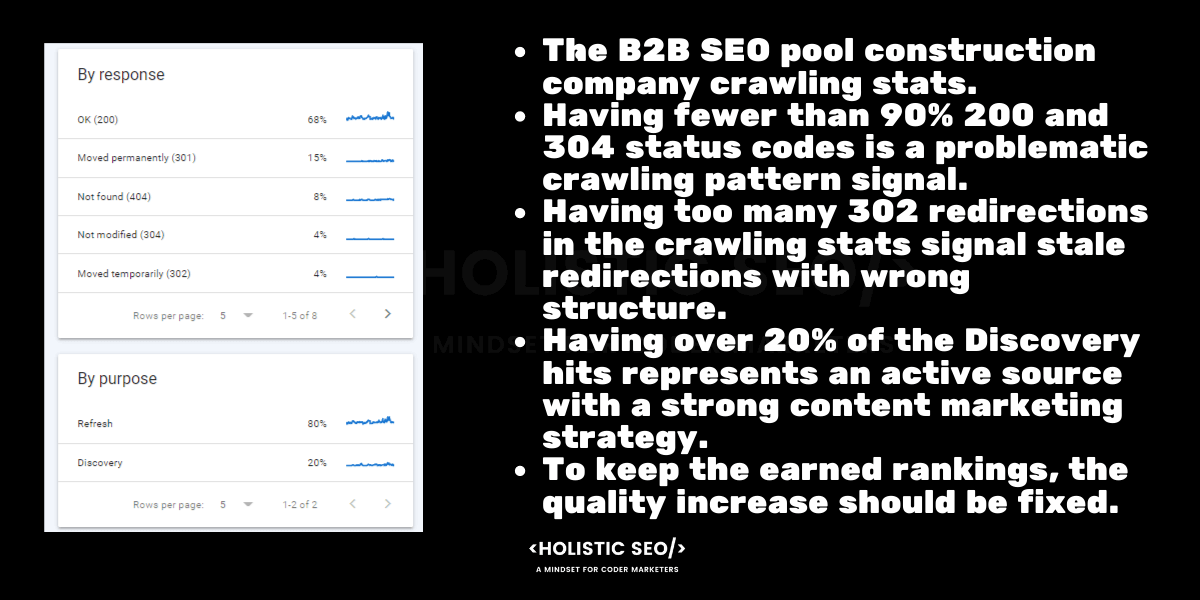
B2B SEO Case Study for Gift Production Industry
The B2B SEO Case Study for Gift Production is related to the Query Semantics highly. The brand name of the B2B SEO Case Study for the Gift Production Industry will be explained. The B2B Gift Production SEO Campaign focuses on mass gift buyers and orders for certain types of local themes from different countries. The B2B Gift Producer and Manufacturer has a production line for producing any desired type of product, but the order value has to be higher than tens of thousands. Thus, the query context and brand purpose are mostly different. To align the brand identity with the query context, the gift-type of query networks are used for a semantic SEO sprint along with other relevance and responsiveness-focused SEO practices. The early results of the B2B SEO Case Study for the Gift Production Industry are below.
- %767.16 organic click increase in 3 Months GSC Comparison
- %1.012 organic impression increase in 3 Months GSC Comparison
- %28,57 Organic CTR Increase in 3 Months GSC Comparison
- %141 Organic Average Position Increase in 3 Months GSC Comparison
- %359,78 Organic Click Increase in the last 6 months.
- From 0 to 30,000 Organic Search Traffic for a Gift Producer in B2B Industry.
- 7800 New Organic Ranking Queries.
- New Top 3 Ranking Queries.
- New 635 Between 4-10 Ranking Queries.
- 3498 New Organic Queries between 11-50 Rankings.
- 1919 New Organic Queries between 51-100.
The SEMrush graphic to demonstrate the organic growth of the B2B SEO project is below.
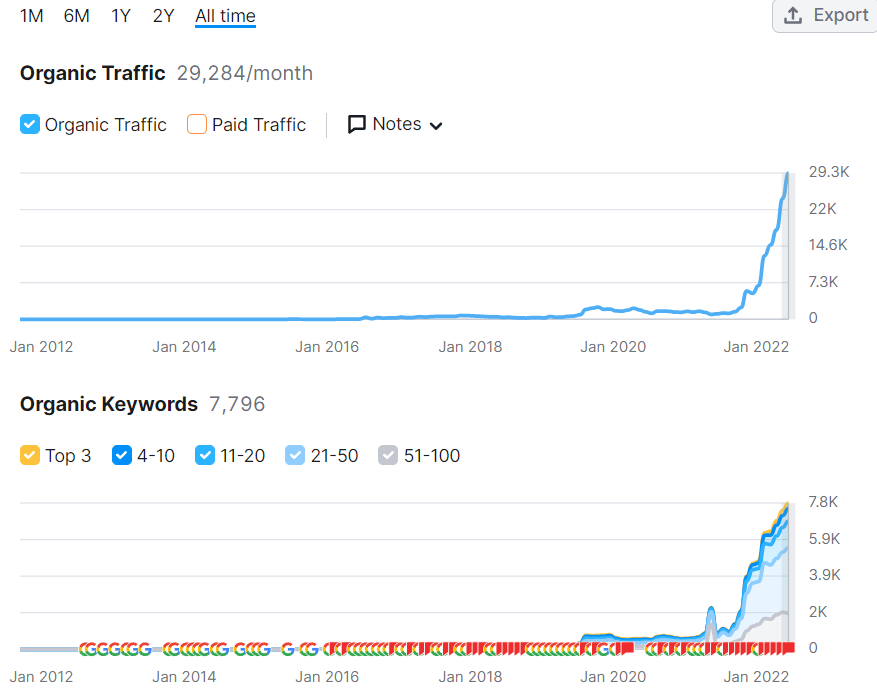
The Ahrefs Organic Growth graphic for the B2B SEO project is below.
- The continuous highest-ranking graphic is clearly seen.
- The Semantic Content Network and created New Product Pages with E-Commerce and B2B Purposes have shown its effect.
- The localized product themes for gifts are used for better semantic relevance and consolidation.
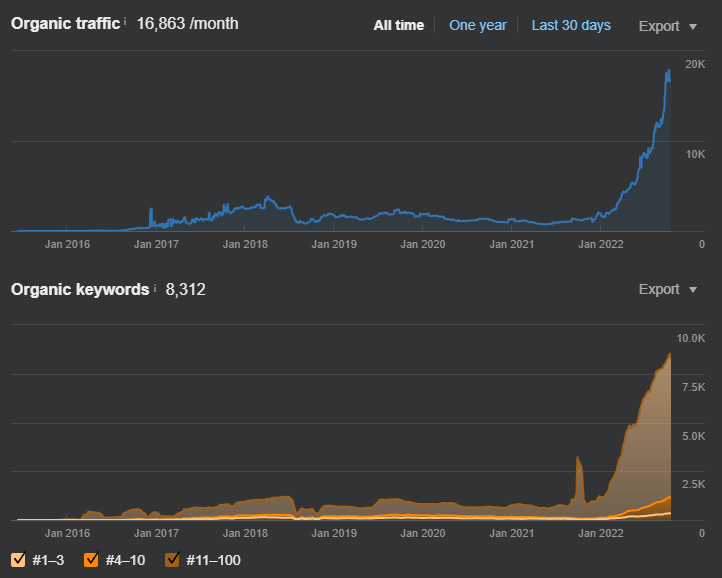
The Google Search Console 3 Months Year Over Year Organic Search Performance Comparison for B2B SEO Gift Industry Project is below.
- From 6730 clicks to 58100 clicks.
- From 124,000 organic impressions to 1,380,000 organic impressions.
- From 5.4% Average CTR to 4.2% Average CTR.
- From 29,5 Average Position to 12,9 Average Position.

The overall change for the B2B SEO Project subject website is below.

The 6 months comparison for the Google Search Console Organic Search Performance for the B2B SEO Gift Industry Project is below.
- From 18,400 clicks to 84,600 clicks.
- From 523,000 Impressions to 2,110,000 Organic Impressions.
- From a 3.5% Average Click-through Rate to a 4% Click-through Rate
- From 17 Average Position to 14.2 Average Position.

The Visual Representation of the GSC 3 Months Y-o-Y Comparison for B2B SEO Gift Website is below. One month later, Google Search Console Report for the B2B SEO for Gift Industry subject website is below with 400% organic growth.


Image Search Growth for B2B SEO Gift Industry Project
Image search is important for B2B SEO because prospects search products and services visually as much as textually. The visual SERP features increase its coverage on the universal web results. The B2B SEO Gift Industry Image Search Growth is given below.
- From 1250 to 3810 Organic Image Clicks
- From 154,000 to 842,000 Organic Image Impressions
- From 0.8% to 0.5% CTR for Image Search
- From 77,2 Average Position to 61,5 Average Image Ranking Position
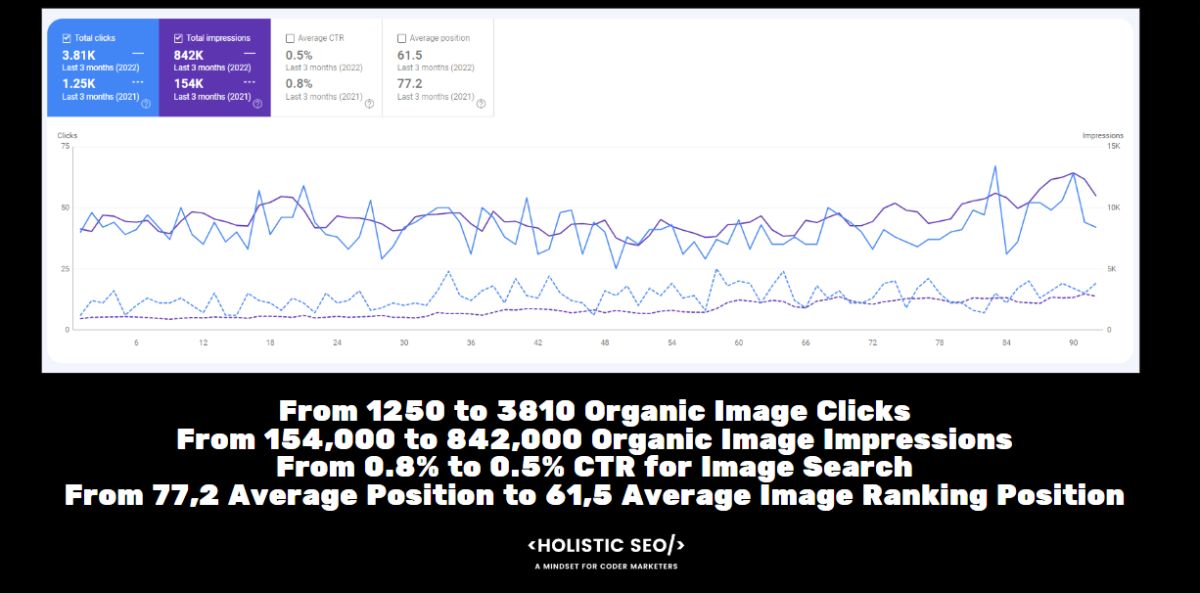
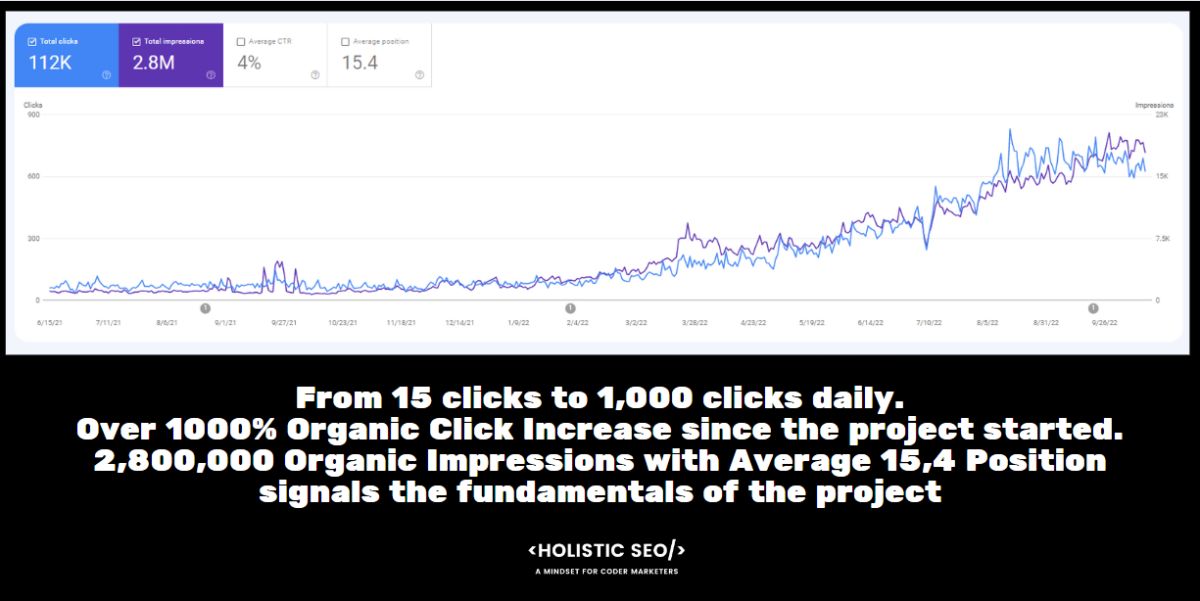




%359,78 Organic Click Increase in Last 6 Months Comparison from the Google Search Console Report of the B2B Gift Industry SEO Case Study is above.
Understanding B2B SEO with Google Search Console Crawl Stats
Understanding B2B SEO with Google Search Console Crawl Stats involves an examination of the total crawl requests, total download size as bytes, and average response time as milliseconds for grasping the effects of the SEO implementations from Googlebot behaviors point of view such as fetching the resources, refreshing the index. The overview and results of the B2B SEO Gift Industry subject website’s crawl stats reports are below.
- The 270,000 crawl hits, 13,4B download size, and 484 MS average response time.
- The PageRank increase with external references increased the crawl requests.
- The indexation speed and indexed web page count have increased thanks to branding and Digital PR.
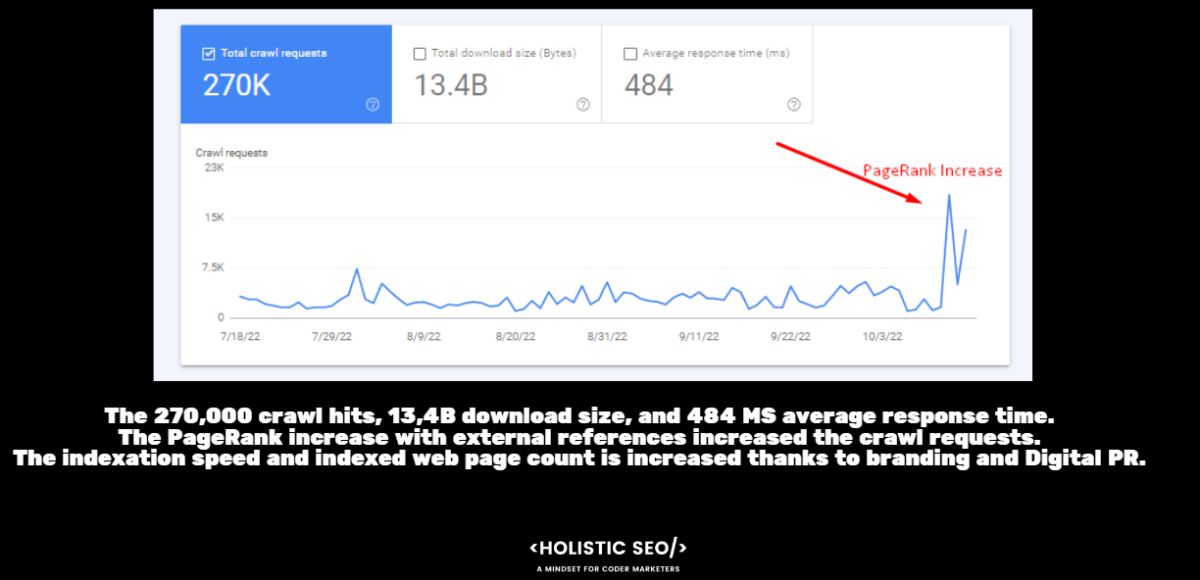
Understanding B2B SEO with Google Search Console Core Web Vitals Scores
Understanding B2B SEO with Google Search Console Core Web Vitals Scores is analyzing and examining the Core Web Vitals metrics of the B2B website within the GSC Report with LCP, TBT, and CLS metrics to see whether the web pages are engaging and user-friendly. To B2B SEO Gift Industry subject website’s GSC Core Web Vitals analysis is below.
- Both Desktop and Mobile URLs have Poor and “Needs to Improvement” URLs.
- There are 2344 Poor Desktop URLs.
- And, there is 2343 Need to be Improved Mobile URLs.
- The reason that the mobile URLs have a higher performance than the Desktop URLs is the mismatch.
- In other words, the web source presents multiple versions of the same website based on the user agents.

Understanding B2B SEO with Google Search Console Crawled Resource, Crawler, and Crawling Types Reports
Understanding B2B SEO with Google Search Console Crawled Resource, Crawler, and Crawling Types Reports involve auditing the crawled resource type such as HTML, Image, CSS, crawler type such as smartphone, desktop, and crawl response status codes such as 200, 404, 301. Understanding B2B SEO with GSC Crawling Stats that involve file types or crawler types is necessary to understand how the website is perceived in a healthy or unhealthy way by the search engine. For example, the excessive amount of 404 status codes in crawl stats, or the fewer HTML requests signal that the website is not crawled properly, or understood by the search engine. The overall analysis and overview of the B2B SEO Crawled Resource, Crawler, and Crawling Type for the B2B Gift Industry is below.
- The HTML hits are over 60% which is good, but still, it is not over 80%.
- The Images have a %20 percent of the share which crawled a lot after the 12th September Core Algorithm Update of Google which affected the website positively.
- The CSS, JS, and Font files are crawled less, but still, there are unnecessary %9 crawls because of the bad-content type.
- JavaScript and Syndication requests are lower than %1.
- The Image requests are over 20%, and they increased via PageRank increase mainly, which signals a way of ranking the images via Landing Pages. Thus, the image search growth should be remembered.

Response Code Analysis from GSC Report for B2B SEO
- The Response Code Status Codes of the B2B SEO Gift Industry are on the left side.
- The B2B SEO Gift Industry Website has %90+ over 304 and 200 status codes, thus it is a healthy crawling pattern.
- But, there are DNS Errors, which are bad for the brand authority in the eyes of the search engine.
- The Brand has %7 discovery hits thanks to always updated product descriptions and newly published content, which keeps the web source active for better ranking states.

What B2B Companies should know about SEO?
The concepts, components, mindsets, and tips for better search engine optimization execution methodologies and results are listed below.
- Understand that a topical map for B2B SEO doesn’t have to be shaped according to personal opinions, or taste.
- Accept that users and customers do not have to be similar to the CEO of the company, or the highest-paid person.
- Find the weak points of competitors in their brand image, and create a Surround Sound, and Barnacle SEO project for a better brand positioning for the B2B SEO Campaign.
- Understand the basic Search Engine concepts to communicate better with the SEO Agency or the Consultant.
- Understand that every SEO tasks collaborate together. A missing SEO improvement might affect the other SEO tasks.
- To learn SEO, use basic and fundamental SEO Books so that communication with SEO is improved.
- Follow the SEO news and updates from Google, Microsoft Bing, and other search engines to understand the future and possible risks or opportunities for the B2B SEO Campaign.
- Do not try to measure the Return on Investment for SEO campaign spending without having the first Broad Core Algorithm Update positive results.
- Create thought leadership to help SEO Campaign with further E-A-T signals.
- Use every license, reward, or exhibition like real-world expertise and quality signal by digitalizing them and opening them to search engine crawlers and users.
- Make the SEO team meet with CTO, Web Developers, and Sales Teams at the same time while using an SEO Mindset and understanding as an activator for higher marketing efficiency.
- Do not differentiate the Paid Search and Organic Search teams from each other completely. Make both teams collaborate for a lesser cost per conversion.
- Do not expect every user, or even every %4 of the users, to create a conversion, or generate a lead for a possible conversion. B2B SEO and marketing aim to create a loyal user base, brand awareness, and brand partners, advocates, and messengers to have a constant and continuous conversion flow.
- Understand the historical data concept for topical authority and search engine trust. Keeping a website, or a certain part of the website bad for a day, month, or three months creates a non-quality signal for the website in the eyes of search engines. These collaborative and marginal negative effects might cause SEO progress to get hindered for B2B marketing purposes.
Why is SEO Important for B2B Marketing?
Search Engine Optimization (SEO) is important for B2B Marketing to take organic traffic from the right audience by ranking the search results higher. Ranking on Google with higher visibility helps B2B Companies to establish online reputation, and autopilot their conversion funnels. B2B Marketing and B2B SEO are connected to each other. Even though, B2B Marketing entails broader activities for B2B SEO, both target the same goal which is increasing revenue by providing sales where the client meets are satisfied. Thus, SEO helps B2B Marketers to increase their conversions. For example, according to Holistic SEO research, the companies that publish 6 blog posts a month acquire at least %26 more leads than other companies. B2B Marketers leverage SEO and content marketing to reach out to a wider audience to increase brand awareness and provide conversions.
What are the SEO Templates for B2B Market?
B2B SEO templates include web page layouts, content marketing strategies, HTML, and CSS templates, along with communication and tonality templates for customers. B2B SEO templates involve checklists for Technical SEO, Local SEO, Branding, and Brand SERP optimization, and more SEO verticals to improve the practical appliance of search engine optimization. B2B SEO Templates are created to help SEOs to create better results while onboarding the B2B company marketing teams better. An example of a B2B SEO template for determining a strategy is below.
- Determining trust elements, and using customer testimonials on the homepage.
- Choosing topical entries as n-grams to distribute to the entire website from the boilerplate content to show the main focus of the web source.
- Opening the company profiles for the platforms that can entail the reviews about the quality service of B2B Companies.
- Creating a glossary section for the B2B Concepts on the company website to demonstrate the expertise.
- Using more readable and brandable typography inside the website.
- Determining brand colors, communication channels, mottos, and social media managers’ tonality for brand positioning.
- Creating a topical map and semantic content network to increase positive user feedback with historical data.
- Determining the amount of CSS, JS, and Font files to be used per web page.
- Using Performance Budgets for a better Page Loading Timing.
- Determining Content Writing Guidelines for the Expert Authors
The B2B SEO Templates change from industry to industry and B2B brand conditions. For example, an automotive manufacturer which has a big author team can leverage the content publication frequency with higher topical coverage, while a solar panel manufacturer can focus on solar panel materials’ advantages to show the products’ efficiency without the need for an extensive amount of content. Thus, B2B SEO templates are shaped and configured according to the industry, topic, and conditions of B2B companies.
What are the B2B SEO Best Practices?
B2B SEO Best Practices are a summary of the B2B SEO methodologies with the highest effective ones such as having a strong Expertise, Authoritevness, and Trustworthiness in the industry, and semantically optimized content networks to consolidate relevance for search queries and keywords better. The best B2B SEO practices for B2B Marketing beginners are given below.
- Create a Buyer Persona to Narrow the Target Audience who has decision-making authority.
- Simplify Conversion Funnels for increasing conversion rate.
- Improve Brand Authority, optimize Brand SERP, and have a positive sentiment about the brand in the reviews.
- Use Unique Information, and Expert level accurate knowledge to prove the expertise of the company.
- Create a proper topical map with related entity-attribute pairs and relations to have a better content network.
The B2B SEO Best Practices involve different SEO verticals’ practices. For example, simplifying conversion funnels as a B2B the best SEO practice focus on user experience, while using unique information for expertise leverage E-A-T with reputative content creation. Thus, B2B SEO Best Practices are quick fundamentals and basics for higher rankings on web search engine result pages.
Last Thoughts on Holistic SEO and B2B SEO
B2B SEO and Holistic SEO are related to each other because B2B SEO involves multiple SEO verticals. Holistic SEO is the unification of multiple other SEO verticals such as local, technical, semantic, and branding SEO verticals. Thus, every B2B SEO Campaign requires using a Holistic SEO mindset and techniques. The Holistic SEO amplifies B2B SEO practices by providing collaborative, multichannel, and consistent quality improvement methodologies for search engines’ algorithms, and users’ visit purposes. For example, a user who is a key decision maker for a company’s purchases of products and goods, audits multiple other service providers and product manufacturers, or material logistic companies to be sure that the production band won’t have a problem. Thus, providing a holistic approach for the user’s possible search journey during one’s exploration stations on the surface of the web by optimizing from social media activities to blog, or email newsletters to exhibitions, licenses, press releases, brand prestige is needed in the context of B2B SEO.
The B2B SEO Guide and Case Study involves B2B SEO Strategies, Practices, Templates, Methods, Mindsets, and Tactics with concrete, real-world B2B SEO Successes, and analysis. The Business to Business Search Engine Optimization guide is refreshed in light of the new information, regularly.
- Sliding Window - August 12, 2024
- B2P Marketing: How it Works, Benefits, and Strategies - April 26, 2024
- SEO for Casino Websites: A SEO Case Study for the Bet and Gamble Industry - February 5, 2024
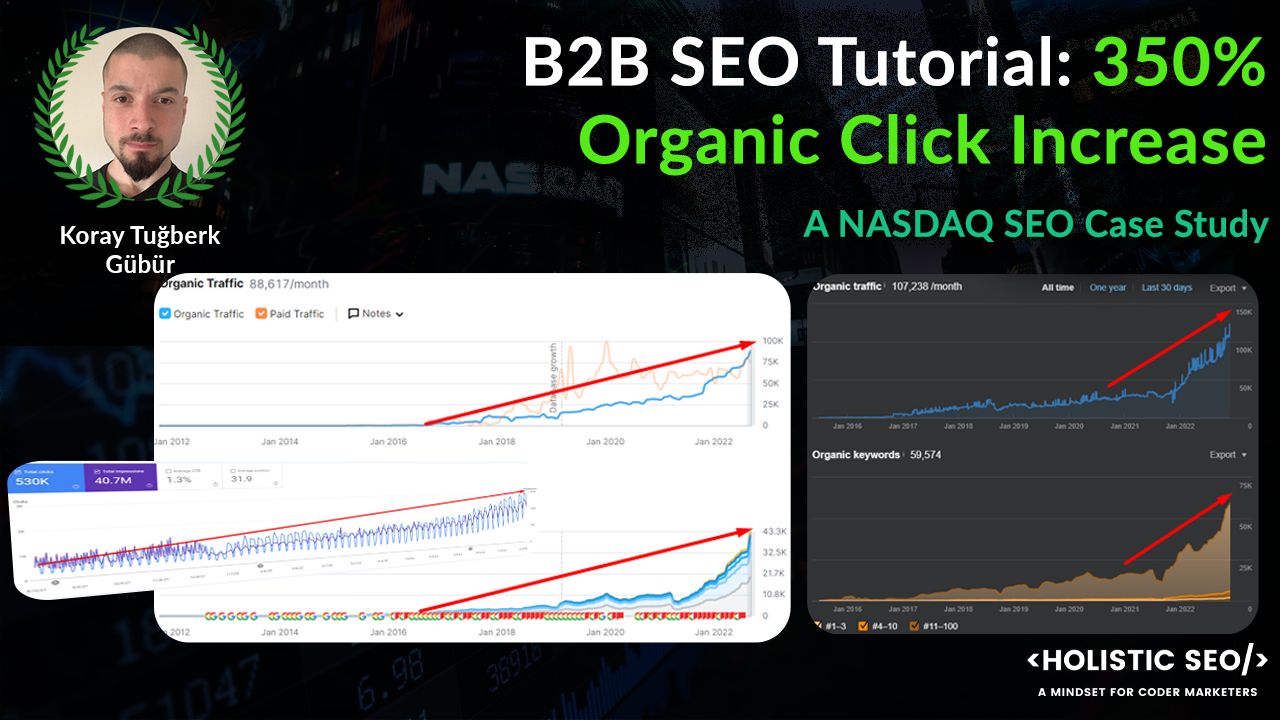
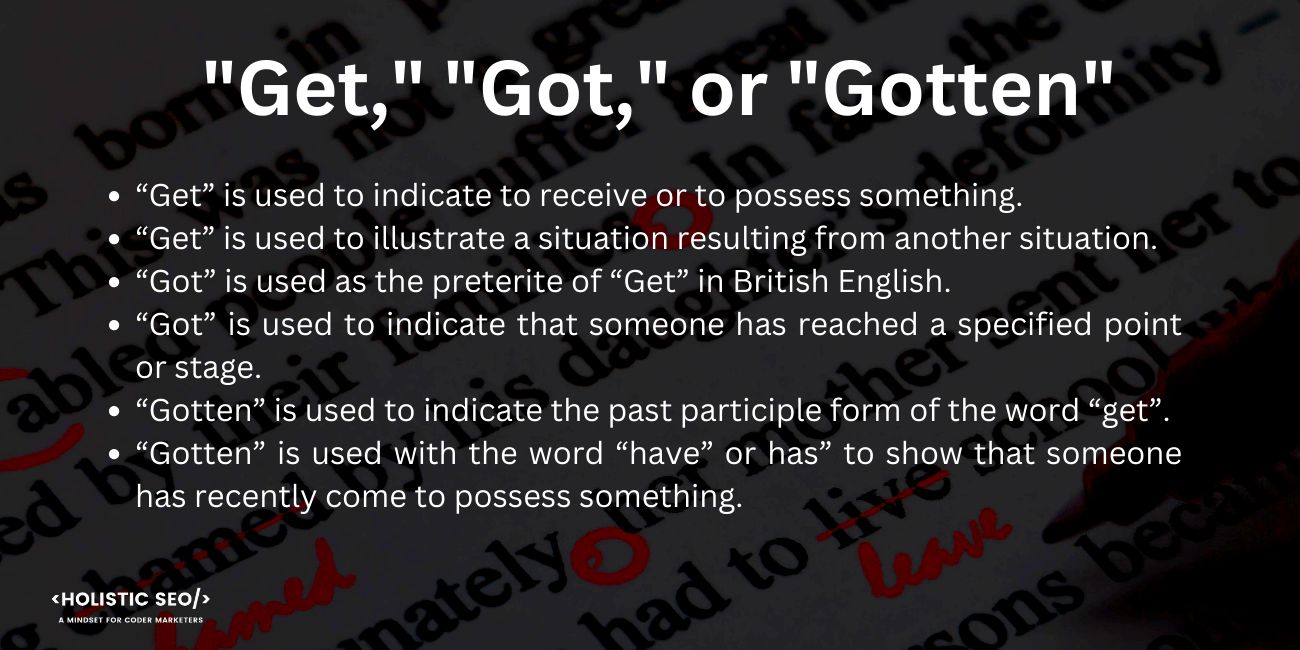
Wow Koray, thanks for your extensive thoughts about B2B. I must admit that we have always used only some of these possibilities, and the worst was when the client simply did not have the manpower to implement the most important elements – developing personas.
I’m also glad that you showed how SEO works with other areas of marketing – unfortunately, there are few sources on this subject, and many people simply think that B2B uses very basics of SEO.
PS: We are waiting for the book!
Thanks for this amazing case study Koray… A lot of notes, take aways, and aha moments here.